Dongguan Yuanfeng Technology GPA05001 GPS Portable Navigation Device with FM/Bluetooth User Manual PA05
Dongguan Yuanfeng Technology Co., Ltd GPS Portable Navigation Device with FM/Bluetooth PA05
Contents
- 1. user manual
- 2. Users Manual
user manual
User Manual
GPS MODEL: PA05

GPS MODEL PA05 User Manual
Statement
Thanks for using GPS MODEL PA05!
z We reserve the rights of final interpretation of the manual.
z The product is subject to change without notice. Please accept our apology for your
inconvenience.
z Please back up your information in the GPS navigator. We assume no responsibility
for any loss caused by material loss.
z The manual might contain a few mistakes though it has been checked. If mistakes are
found, please contact the YF customer service center.

Read Me First
z Please read the instructions in this manual and use only original accessories to avoid
unpredicted damage. Failure to follow the instructions will invalidate warranty and
might endanger personnel safety, for which we assumes no responsibility.
z Data of navigation electronic maps might be inconsistent with actual traffic signals
due to transportation development. Please follow traffic regulations and signs and
drive according to road situation. Operating the GPS navigator device while driving
might cause serious accidents. We assume no responsibility for accidents and loss
due to improper use.
z The drive circuit the navigator provides is for you information. Drivers should be
aware of the road conditions, weather conditions and other factors affecting safe
driving meanwhile.
z For information of software update and upgrade, please go to our website
www.yfgps.com.
z The pictures in the manual are subject to the material object.

Table of Contents
Chapter I Welcome....................................................................................................................1
Chapter II Beginning Use ........................................................................................................2
2.1 Power Supply & Charging.......................................................................................................................2
2.2 Basic Use.....................................................................................................................................................3
2.3 System Main Interface and Major Functions...............................................................................................5
Chapter III GPS .............................................................................................................................7
3.1 Map .............................................................................................................................................................7
3.2 Navigation .................................................................................................................................................7
3.3 Reception.....................................................................................................................................................7
Chapter IV Media .......................................................................................................................8
4.1 Music Player................................................................................................................................................8
4.2 Video Player............................................................................................................................................ 11
4.3 Photo Browser...........................................................................................................................................13
4.4 E-book Reader...........................................................................................................................................15
Chapter V Bluetooth..................................................................................................................20
5.1 Pair ............................................................................................................................................................20
5.2 Making a Call............................................................................................................................................21
5.3 Answering a Call .......................................................................................................................................23
5.4 Dial Record ...............................................................................................................................................24
5.5 Redial ........................................................................................................................................................24
5.6 Setting .......................................................................................................................................................25
5.7 Paired Device List.....................................................................................................................................26
5.8 Search Bluetooth Device...........................................................................................................................28
5.9 Phonebook.................................................................................................................................................29
Chapter VI Games ......................................................................................................................30
6.1 Othello.......................................................................................................................................................30
6.2 BoxMan.....................................................................................................................................................30
Chapter VII Tools........................................................................................................................31
7.1 Calculator..................................................................................................................................................31
7.2 Unit............................................................................................................................................................31
Chapter VIII Settings..................................................................................................................33
8.1 Summary ...................................................................................................................................................33
8.2 Volume ......................................................................................................................................................34
8.3 Backlight ...................................................................................................................................................35
8.4 Language...................................................................................................................................................35
8.5 Date& Time...............................................................................................................................................36
8.6 Calibration.................................................................................................................................................36
8.7 System Info ...............................................................................................................................................37
8.8 FM Transmitter.......................................................................................................................................38
8.9 USB Setting...............................................................................................................................................38
8.10 Navigation Path.......................................................................................................................................40
8.11 Factory Reset...........................................................................................................................................41
Chapter IX GPS Info...................................................................................................................42
Chapter X Favorites...................................................................................................................43
Chapter XI Explorer ...................................................................................................................44
Chapter XII Troubleshooting ................................................................................................45

Operation Instruction
1
Chapter I Welcome
Thanks for using the GPS MODEL PA05. With navigation as the major function, it also
supports audio play, video play, photo browsing and e-book reading.
9 SiRF Atlas-IV duel core CPU with high performance and low power consumption
9 Friendly user interface for simple operation
9 Power management for longer and more stable operation
9 Data transmission with computers via Mini USB
9 Quality reception for accurate positioning and satisfactory navigation service
9 Leisure partner with audio/video/amusement functions
You may use the GPS navigator anytime anywhere, for example while driving, walking or
cycling. Its navigation and amusement functions will enrich your life and work!
To fully exert the functions of GPS MODEL PA05 and to understand the operation details,
please read the manual carefully.
You may see the following supplemental information in the manual.
[Note]: Explanation of relevant subjects
[Relevant Information]: Extra information of relevant subjects
[Attention]: Precautions or warnings of relevant subjects. Please pay attention to this
information and follow the instructions to avoid devastating influence on yourself and
others.
This manual is applicable only to the GPS MODEL PA05.

2
Chapter II Beginning Use
This chapter introduces the appearance, components and basic operations of GPS
MODEL PA05.
2.1 Power Supply & Charging
Charge the GPS navigator fully with the charger before first use.
2.1.1 Power Supply
GPS MODEL PA05 can be powered by the built-in battery or external power supply.
When the GPS navigator is unconnected to the charger, it is powered by the Li-polymer
battery. The battery capacity icon「 」in the system main interface shows current
residual battery capacity.
When the GPS navigator is connected to the charger, it is powered by external power and
the battery is charged.
[Attention] The GPS navigator adopts internal non-removable Li-polymer battery. To avoid
battery rupture, explosion, release of hazardous substance or burn, do not unpack, pierce,
strike on or discard the battery in fire or water.
The work temperature of the device is 0~50°C and its storage temperature is -10~60°C.
Do not leave the device under heat sources or in high thermal areas such as an
unattended vehicle in the strong sunshine. To avoid device damage, move it apart from
vehicle and store it far from sunlight when not using it.
End-of-life battery disposal please follow local relevant regulations
2.1.2 Charging by AC Adapter
The GPS navigator must be charged with the AC adapter before first use.
Plug the USB terminal of the AC adapter into the USB port on the left side of the GPS
navigator and the other to the power socket to supply power and charge the GPS
navigator.
[Note] The charging indicator light is red during charging. Do not unplug the AC adapter
until the battery is fully charged and the indicator light turns green. Please charge the GPS
navigator when the battery is low or used up in succeeding use.
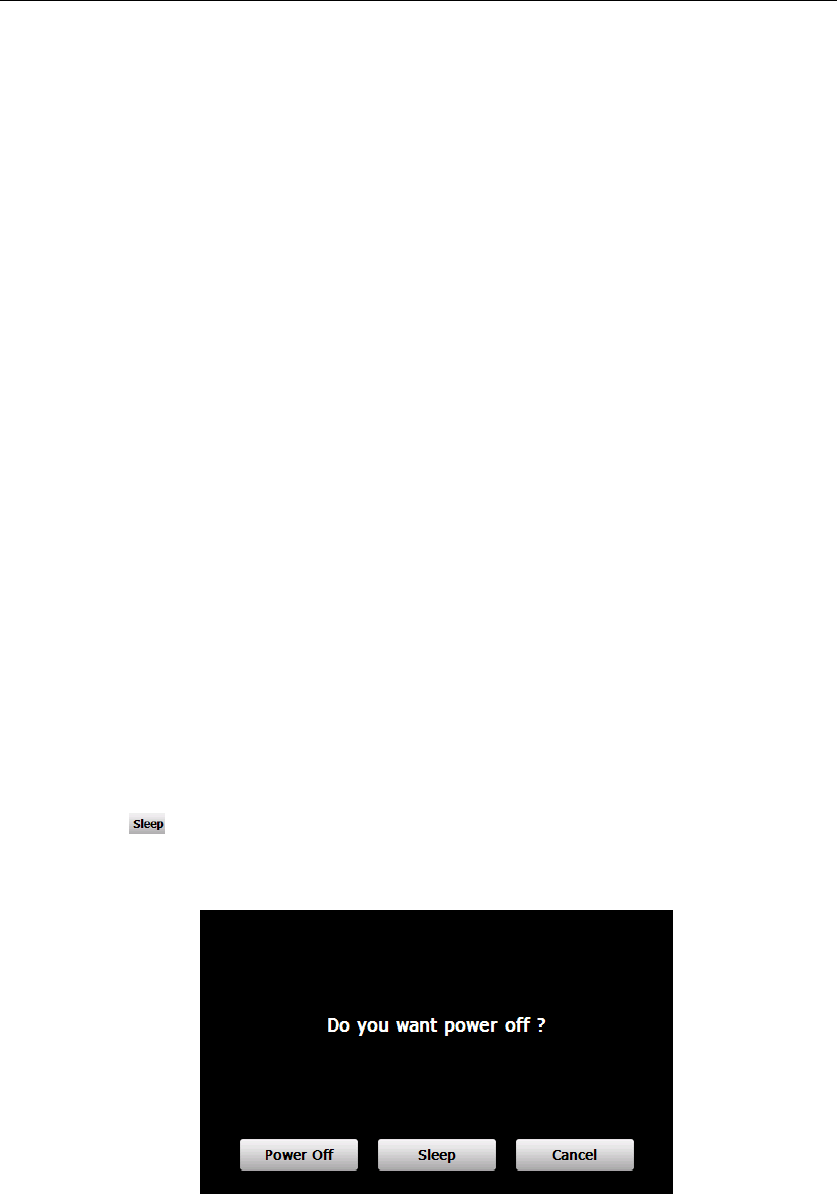
3
2.1.3 Charging by Car Charger
Plug one terminal of the car charger into the USB port on the left side of the GPS
navigator and the other to the charging port to supply power and charge the GPS
navigator.
[Note] Plug in the car charger after the automobile is started to avoid damage due to
current surge.
2.2 Basic Use
2.2.1 Powering on/off & Sleep
2.2.1.1 Powering on
Long press the power key on the top side of the GPS navigator to power it on.
[Note] Great humidity fluctuation may lead to short circuit of the GPS navigator. Power on
the navigator after it has accommodated to new environment.
2.2.1.2. Powering off & Sleep
Long press the power key to power off the GPS navigator. The following interface will be
prompted. If is selected, the navigator will automatically resume the state before
entering sleep mode when powered on again.
2.2.2 Restarting the System
When the system does not response, press the reset key on the back of the GPS
navigator to restart the system.

4
[Relevant Information] The following situations might lead to no response of the system.
1. Delay or stagnancy in interface switching;
2. Failure of function activation with overlong execution;
3. Failure to power on/off the GPS navigator by pressing the power key
[Note] Restarting the system by pressing the reset key will result in loss of unsaved data.
Please backup your data regularly.
2.2.3 Fixing the GPS Navigator with Mounting Kit
The mounting kit is composed of a cradle and a bracket. To use the GPS navigator in an
automobile, fix the mounting kit on the dashboard under the front windshield.
[Note]: Do not place the GPS navigator in positions obstructing the driver’s vision, for
example at the steering wheel, pedal or gear lever. Do not place it without fixing it or in the
place of air bag or the area after the air bag is inflated.
While using the mounting kit, follow local regulations. We will have no responsibility for
any penalty or damage resulting from traffic violation.
2.2.4 Using T-FLASH Card
Copy mapping applications, map data and media files in a T-FLASH card. Insert the card
in the corresponding slot.
[Note]
1. Do not take out the T-FLASH card while a navigation program is being run or a
media file is being played.
2. To avoid drop or crash of the T-FLASH card, do not exert heavy pressure on it or
bend it.
3. Avoid using or storing the T-FLASH card in high temperature, high humidity or direct
sunlight. Keep the card away from liquid or corrosive substance.
4. Mind the direction while inserting the T-FLASH card to avoid damaging the slot or
the card.
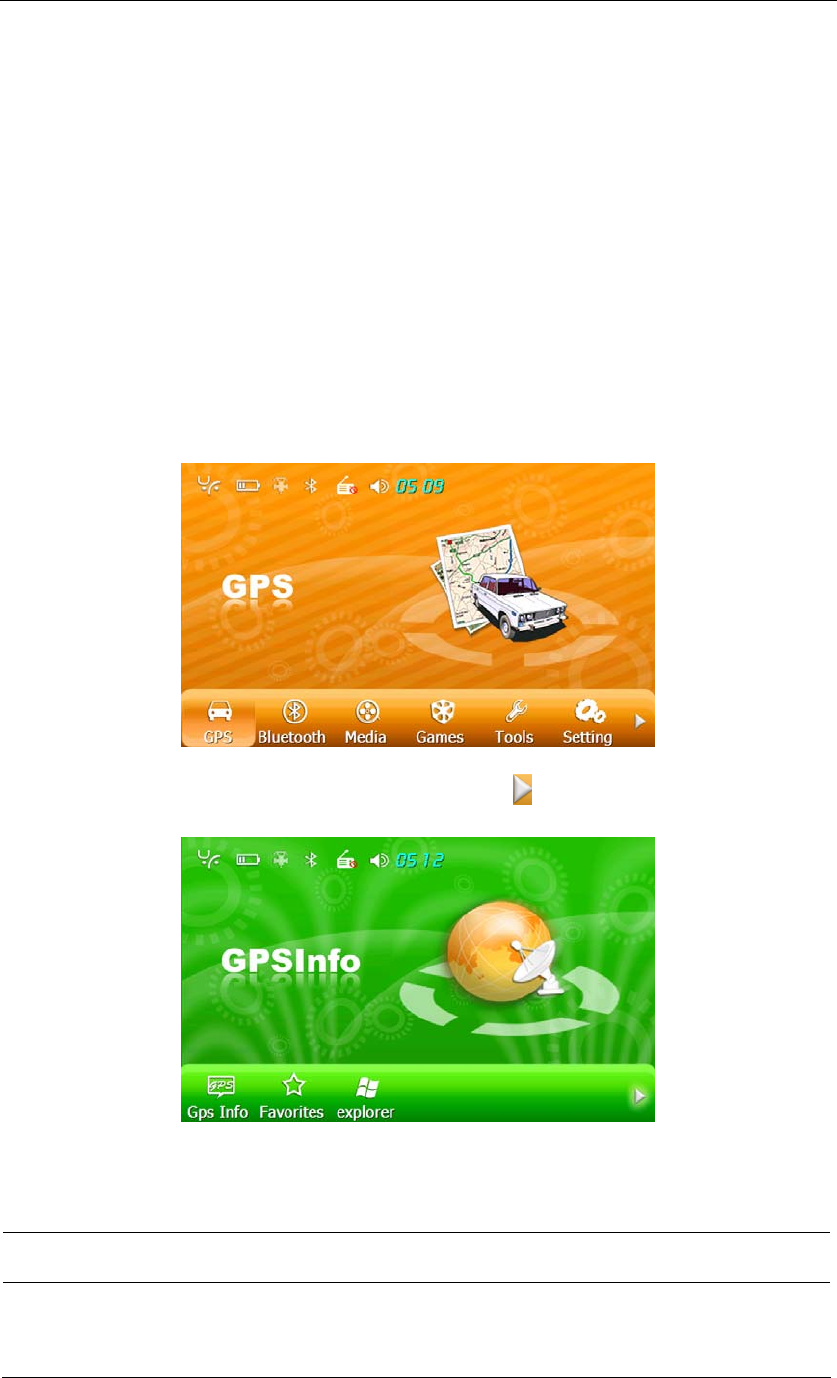
5
2.2.5 Using Touch Screen
To protect the touch screen, do not operate it with acute objects. To cleanse the screen,
use soft cloth with water, isopropyl alcohol or glasses cleanser. Do not use detergent
containing ammonia.
2.3 System Main Interface and Major Functions
Long press the power key on the top side of the GPS navigator to enter the system
main interface as follow:
View the next page as follow by pressing the icon at the bottom of the interface.
Main functions of the navigator are listed as follow:
Function Explanation
GPS Tap to enable navigation function.
Music player WMA9, OGG, AAC, M4A and WAV files supported,
Random, sequence and cycle play supported.

6
Video player WMV, ASF , 3GP, and AVI files supported;
Adjustment of playing progress, pause and full-screen play supported
Photo browser JPG,GIF,BMP and PNG files supported;
Photo rotation, zoom in/out and auto play supported
E-book TXT files reading supporting page selection
Games Othello, BoxMan
Tools Calculator, Unit
Settings Volume, Backlight, Language, Date& Time, Calibration, FM
Transmitter and System Information.
GPS Info Display GPS signal state, reset GPS signal
Favorites Collect programs ended up with .exe under WinCE system
Explorer Tap to enter the WinCE system , push Reset button to restart up the system

Operation Instruction
7
Chapter III GPS
Various navigation mapping applications can be installed in the GPS navigator, such as
CARELAND and RITU intelligent navigation systems, which position the navigator via the
satellite receiver and display it on the map. Set a destination, and the system will
automatically work out the best path to help the user reach the destination safely and
quickly.
3.1 Map
Due to transportation development, inconformity between products and real traffic
information will occur a period after product release. Please drive according to road
conditions and abide by traffic regulations.
3.2 Navigation
Navigation paths are for reference only, and the user may decide whether to follow them.
In some instance your good knowledge of the road condition may take priority
3.3 Reception
High and crowded structures (such as inside of tunnels, space between high buildings,
underground car parks and under viaducts), weather change or satellite signals turnoff
may influence signal reception, resulting in positioning failure, inaccurate positioning,
navigation failure or system function abnormity.
With stereoscopic maps, instant animation, voice prompt and text prompt of the navigation
system, you will appreciate its unique charm and enjoy a great trip.
Different navigation maps may have different operation methods. Please follow
instructions of corresponding navigation mapping applications.
[Note]: Before using the GPS navigator, please purchase and install mapping applications
and appoint file paths. For setting methods please refer to 8.10Setting Navigation Path.
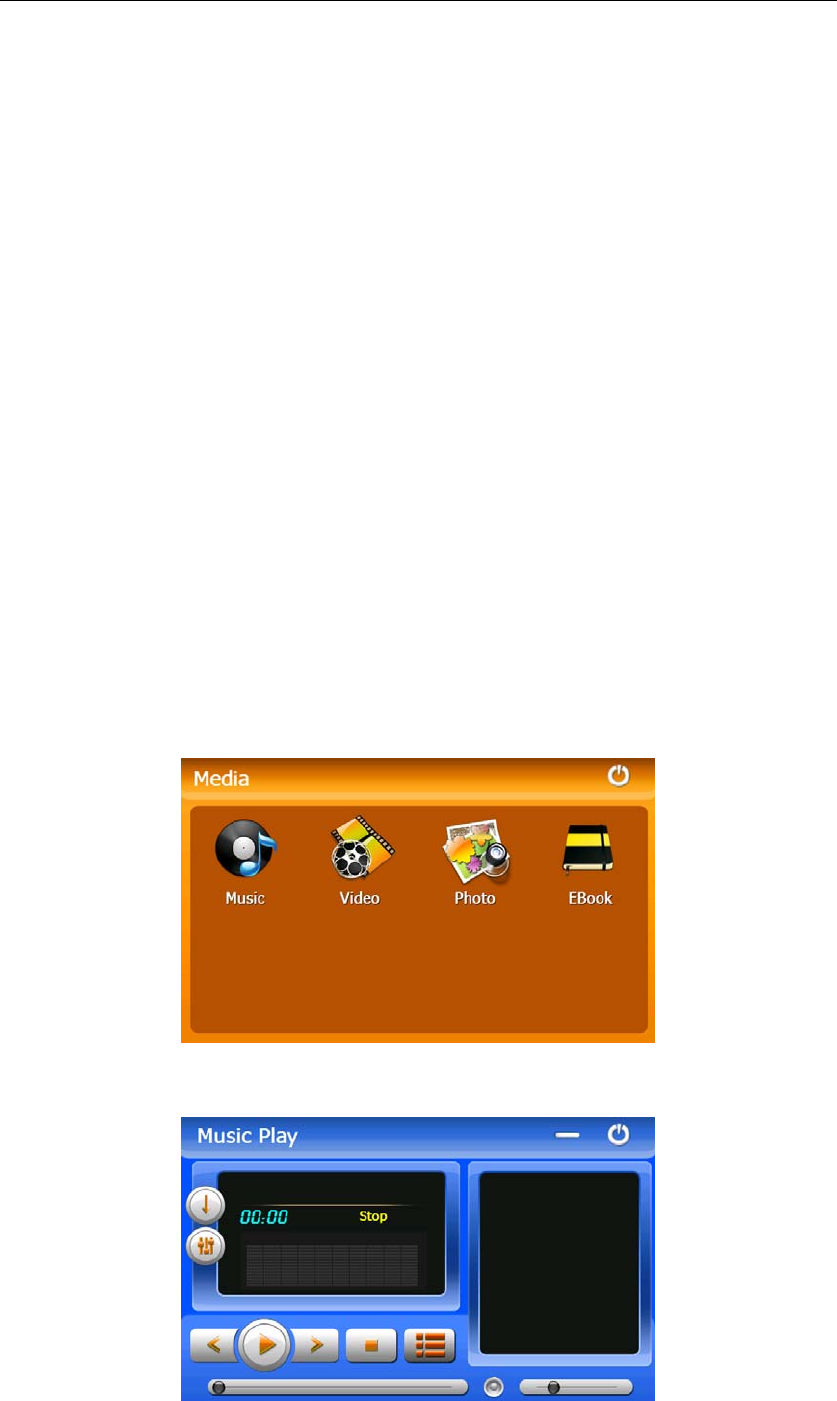
Operation Instruction
8
Chapter IV Media
The Media function includes the music player, video player, photo browser and e-book
reader.
4.1 Music Player
This section introduces the usage of the music player.
4.1.1 Features
The music player supports WMA9, OGG, AAC, M4A and WAV files and selection of play
sequence.
Copy audio files into your memory card before using the player.
4.1.2 Interface and Operation
Tap「Media」in the system main interface to enter the「Media」interface as shown below:
Tap the icon「Music」in the 「Media」interface to enter the Music Play as follow:
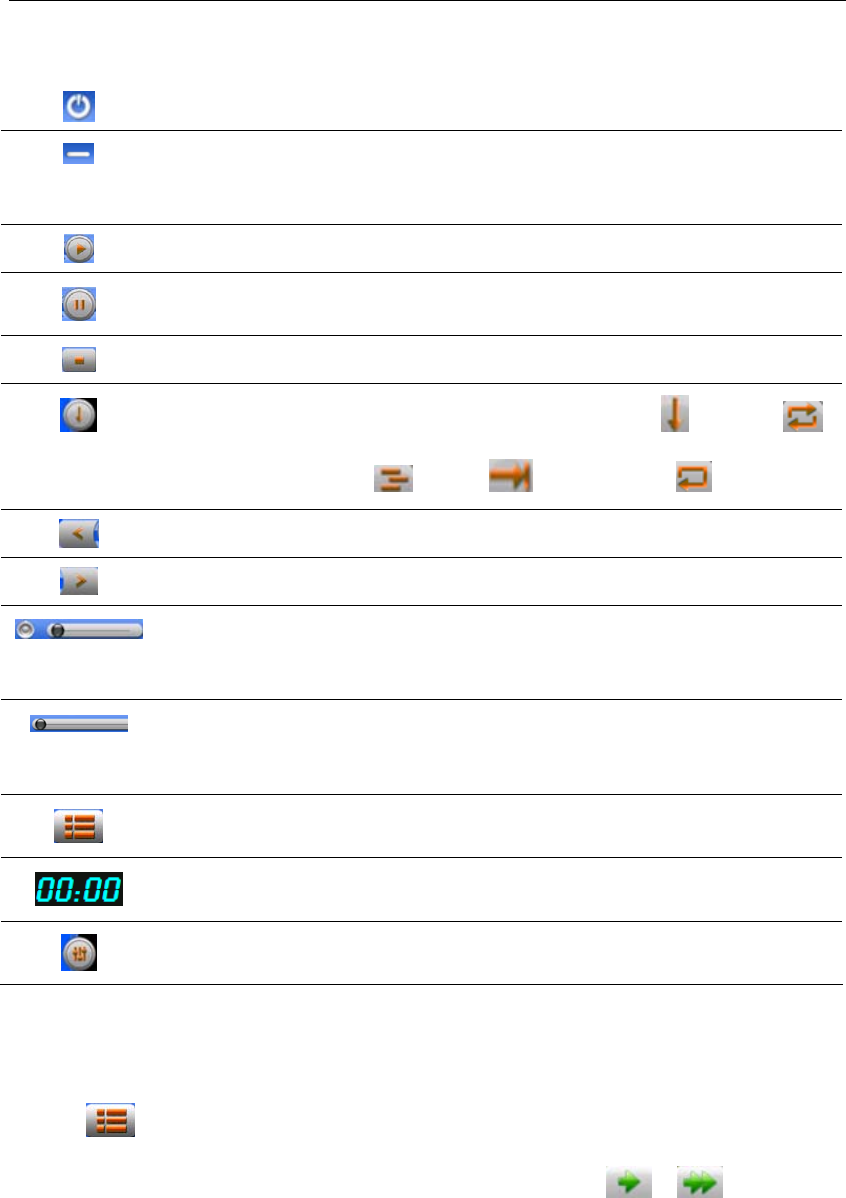
Operation Instruction
9
Close Close the music player
Minimize Minimize the music player and return to the Media
interface.
Play Continue playing the paused/ stopped music.
Pause Pause the music playing
Stop Stop the music playing.
play
sequence
Tap to switch play mode among Order , AllCyc ,
Random , Once and OnceCyc .
Previous Play the previous music.
Next Play the next music.
Volume Drag it leftward to turn down or rightward to turn up the
volume.
Progress Drag it leftward or rightward to play from a previous or
future moment.
Music list Enter it to select music to play.
Time Display the run time.
Equalizer Enter the equalizer
4.1.3 Selecting and Playing Music
Tap in the Music Play interface to enter the Music List interface as follow. Tap to open file
folder in the left to select wanted music from flash memory and tap / to add them
into the play list, double tap a piece of music to start playing.
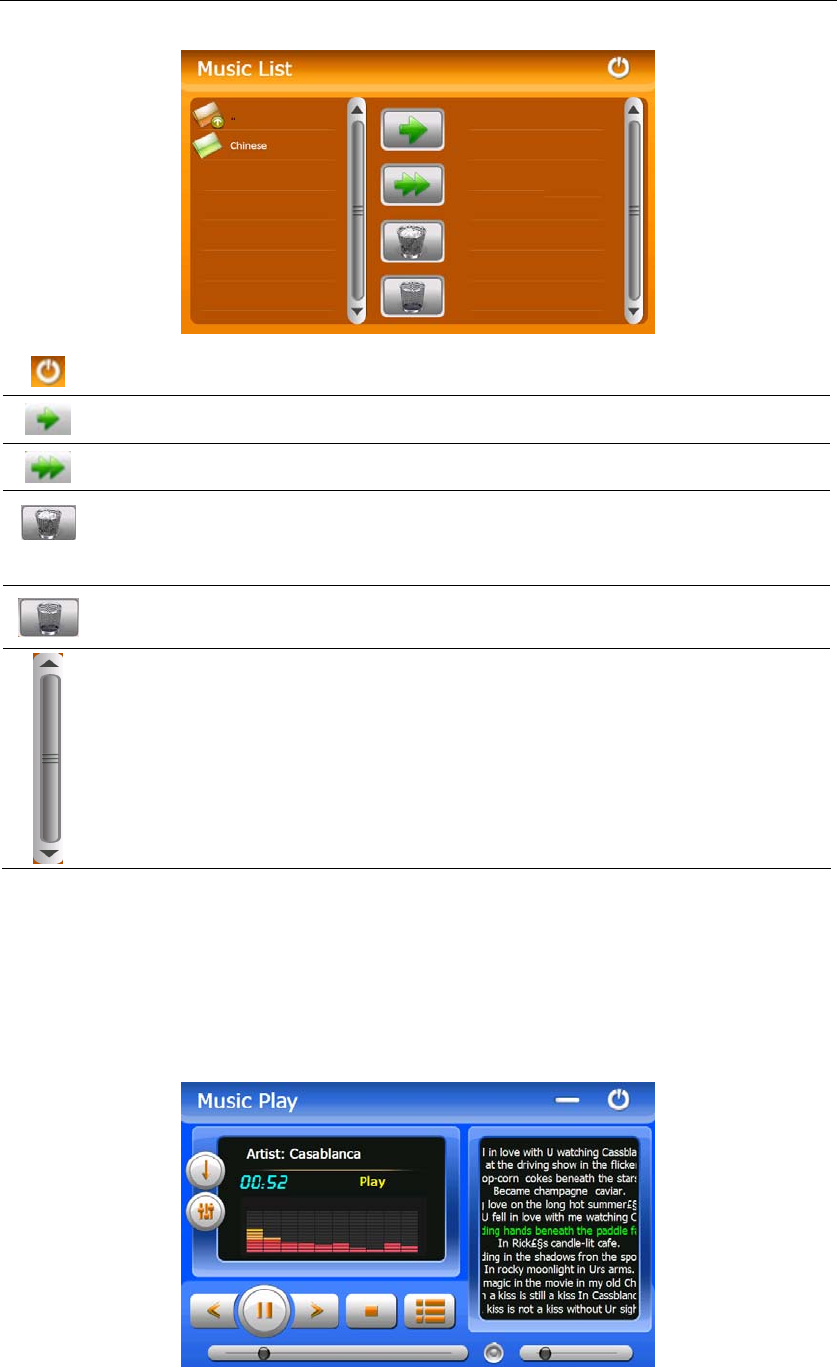
Operation Instruction
10
Close Close the Music List
Add one Add a piece of music on the left list to the play list on the right.
Add all Add all the music on the left list to the play list on the right.
Delete one Select one piece of music in the play list and tap the icon to
delete it.
Delete all Delete all the music in the play list.
Scroll bar Drag it upward/ downward to view all music.
4.1.4 Viewing Lyrics
If your memory card contains corresponding . lrc files for the music being played, then
lyrics will be played at the right side of the Music Play interface:
Double tap the lyrics area to view the lyrics in full screen as shown below. Under full
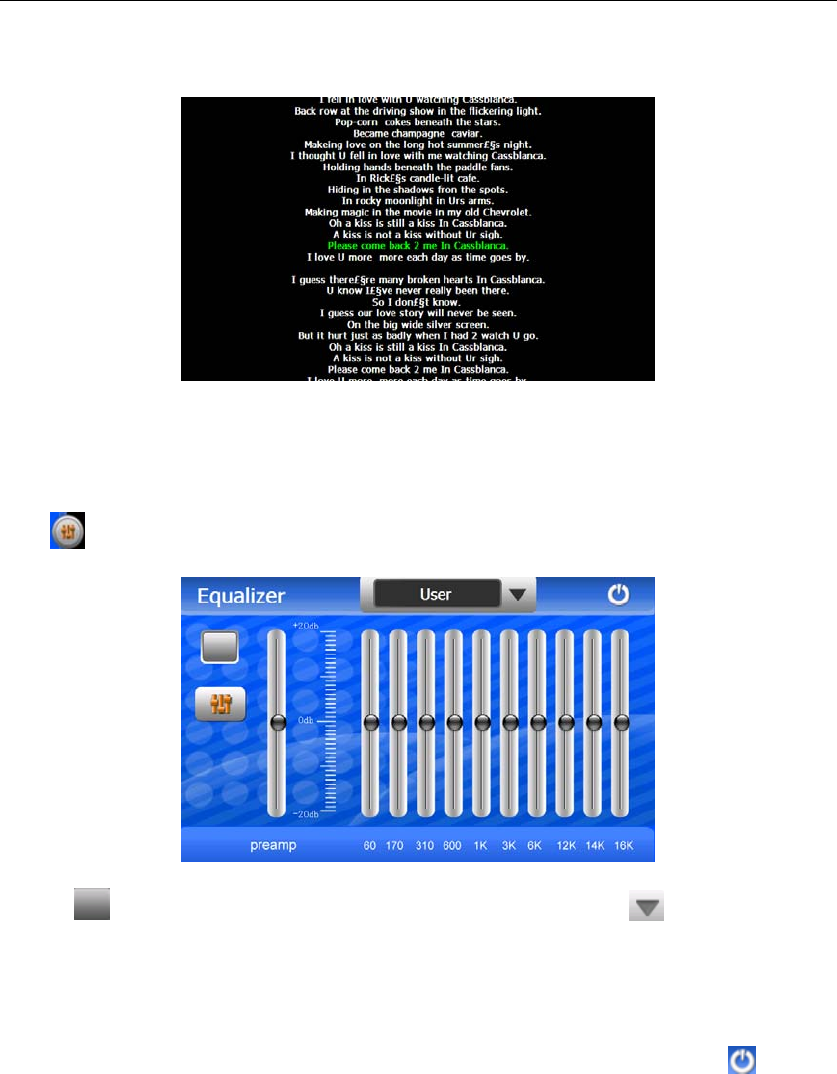
Operation Instruction
11
screen mode, double tap the screen to return to normal-sized interface.
4.1.5 Set the Equalizer
Tap in the Music Play interface to enter the Equalizer Setting interface as shown below:
Tick in on the upper left of the above interface, and then tap to select a music
type or “User” from the drop-down menu. The music types include Pop, Rock, Metal,
Dance, Electronic, Country, Jazz, Oldies, Blues, Nostalgia, Opera and speech. If “User” is
selected, you may drag the slider at will to set the equalizer. After setting, tap to save
and return to the Music Play Interface
4.2 Video Player
This section introduces the usage of the video player.
4.2.1 Features
The video player supports WMV, ASF, 3GP, and AVI files, full-screen play, progress
selection and file selection.
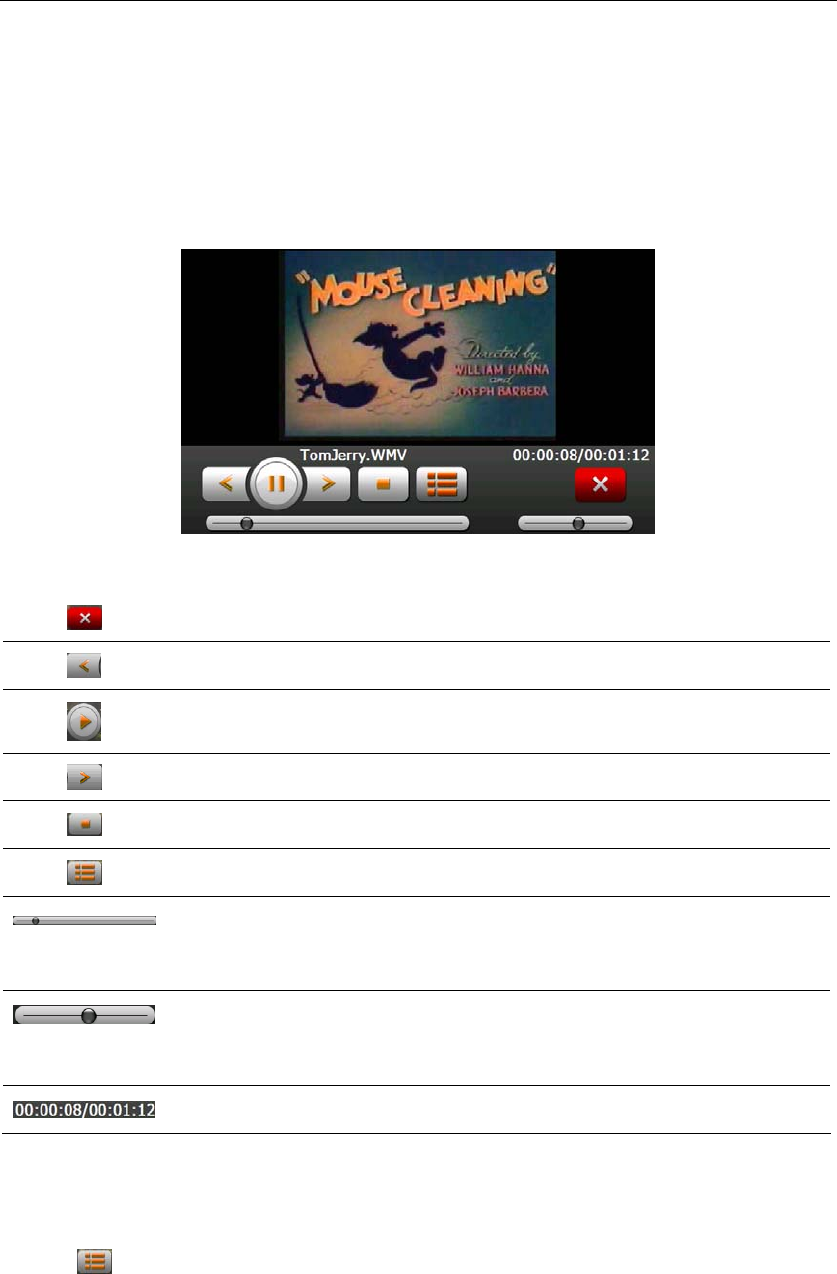
Operation Instruction
12
Copy video files to a folder in your memory card before using the player.
4.2.2 Interface and Operation
Tap 「Video」in the Media interface to enter the video player interface shown as below:
Close Close the video player.
Previous film Play the previous film.
Play Continue playing the paused/ stopped music.
Next film Play the next film.
Stop Stop the film being played.
Video folder Enter it to select a film to play.
Progress Drag the sliding block leftward to play from a
previous moment or rightward coming moment.
Volume Drag it leftward to turn down or rightward to turn up
the volume.
Time Display the play time and the film duration.
4.2.3 Selecting and Playing Video
Tap in the Video Play interface to enter the Video List interface as follow. Double tap a video
file folder to start circle play all video files in the folder.
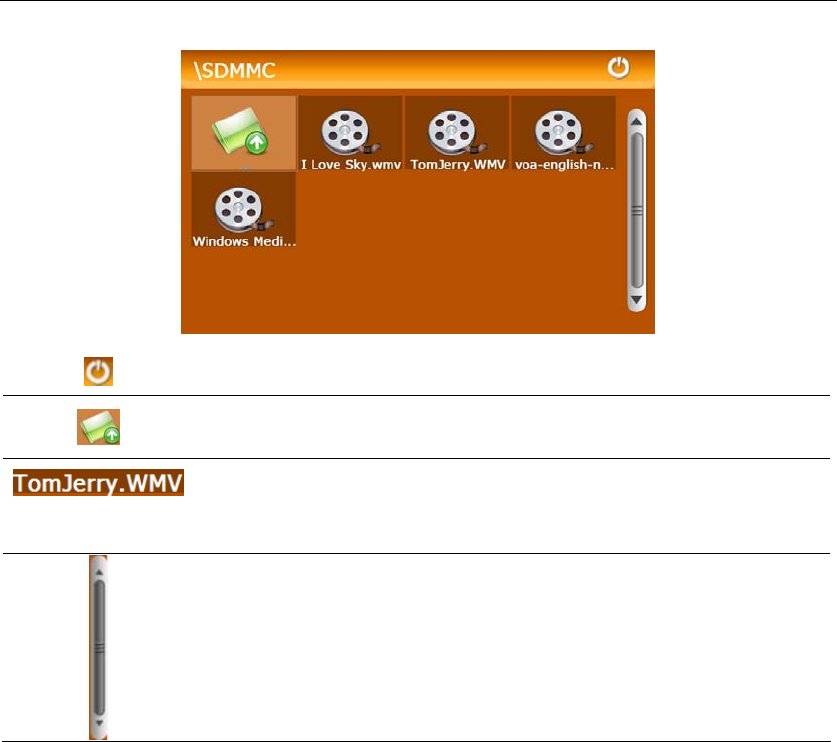
Operation Instruction
13
Close Close the video folder.
Return Return to the previous folder.
Film name&
format Film name and its format
Scroll bar Drag the sliding block upward/ downward to
view all the files inside the folder.
4.3 Photo Browser
This section introduces the usage of the photo browser.
4.3.1 Features
The photo browser supports JPG, GIF, BMP and PNG files, photo rotation, zoom in/ out
and auto play.
Copy photos to a folder in your memory card before using the browser.
4.3.2 Interface and Operation
Tap 「Photo」in the Media interface to enter the photo browser interface shown as below:
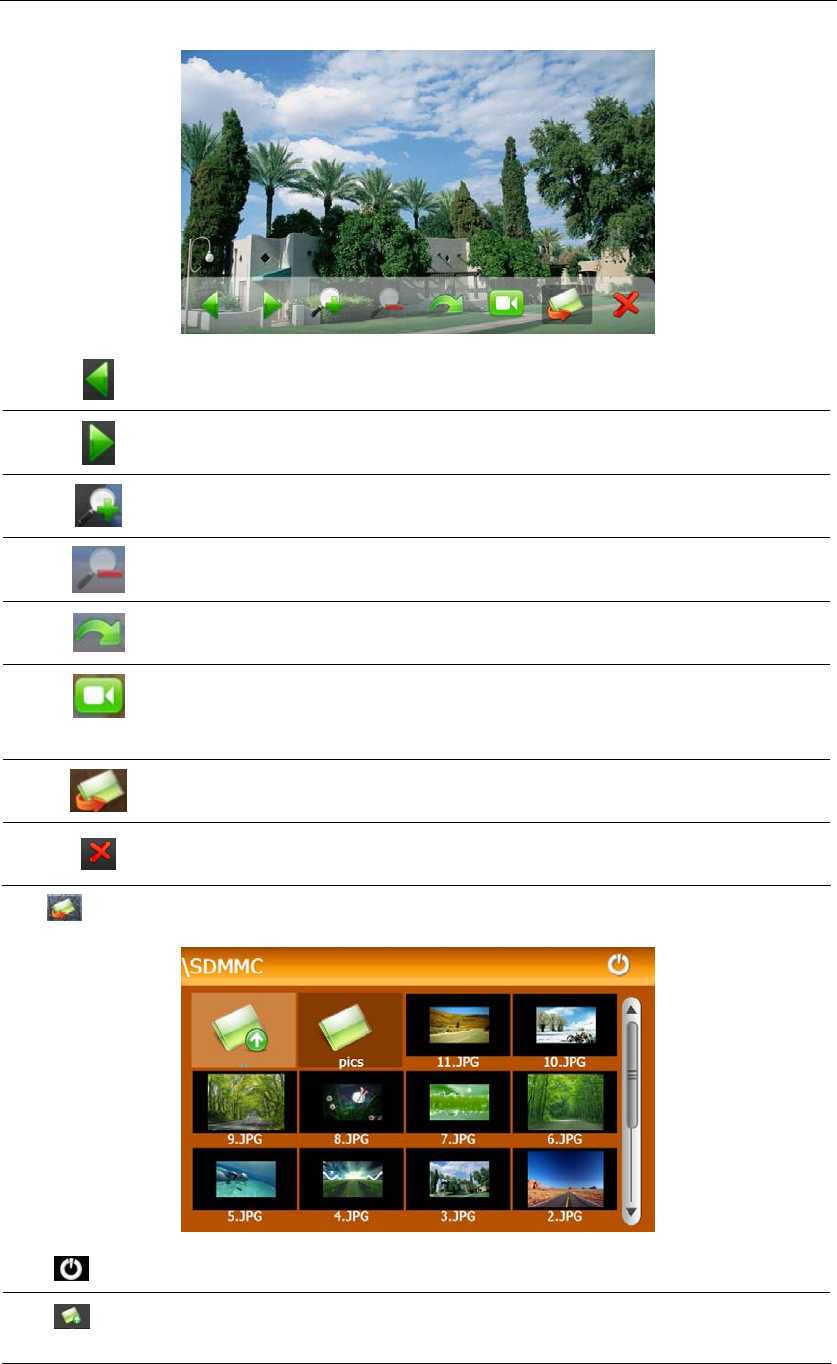
Operation Instruction
14
Previous View the preview photo in the folder.
Next View the next photo in the folder.
Zoom in Scale up current photo.
Zoom out Scale down current photo.
Rotate Rotate current photo 90°clockwise.
Auto play Cycle play all the photos in the folder from current
photo.
Folder Enter the photo folder to select a photo.
Close Close the browser and return to the Media interface.
Tap in the browser interface to enter the photo folder shown as below:
Close Close the current folder.
Return Return to the previous folder.
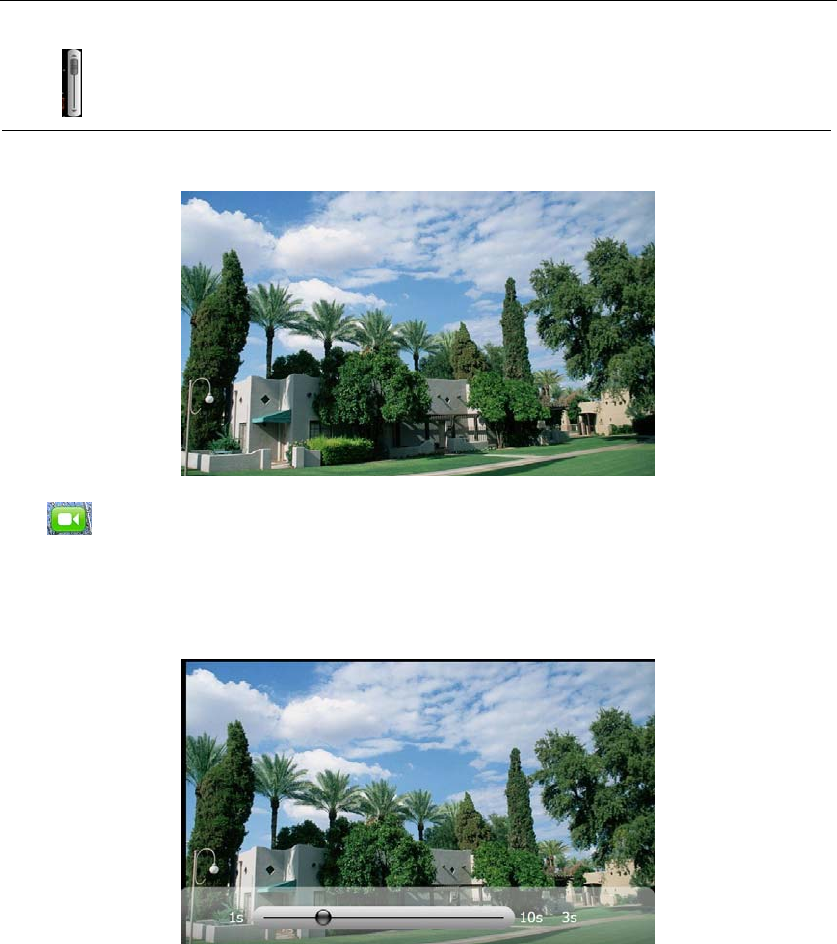
Operation Instruction
15
Scroll bar Drag the sliding block to view all the photos.
In the above interface, double tap on the screen to display photos in full screen:
Tap to enter auto play interface as shown below. Drag the slider at the bottom of the
screen to regulate play speed (1-10 seconds), and then tap on the screen to hide the slide
(or the slide will be hidden automatically); tap on the screen to show the slide. Double tap
on the screen to stop playing and return to the browsing interface.
4.4 E-book Reader
This section introduces the usage of the E-book reader.
4.4.1 Features
The reader supports TXT files, page turn and folder selection.
Copy TXT files into your memory card before using the browser.
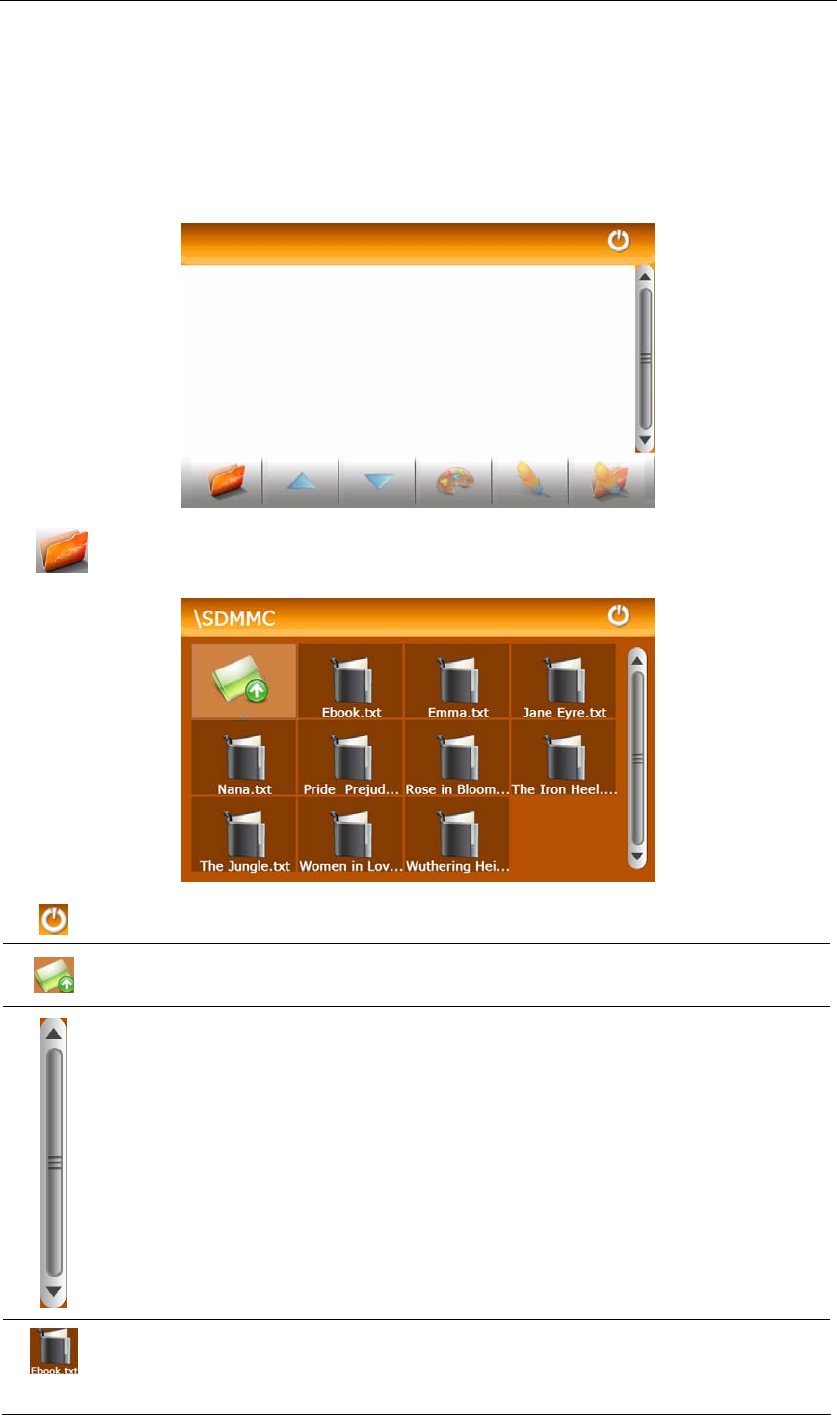
Operation Instruction
16
4.4.2 Interface and Operation
Tap the icon 「Ebook」 in the Media interface to enter the reader interface shown as
below:
Tap in the e-book reader interface to enter the e-book folder shown as below.
Close Close current folder.
Return Return to the previous folder.
Scroll bar Drag the sliding block upward/ downward to view all TXT
files.
File name&
format The file name and format.
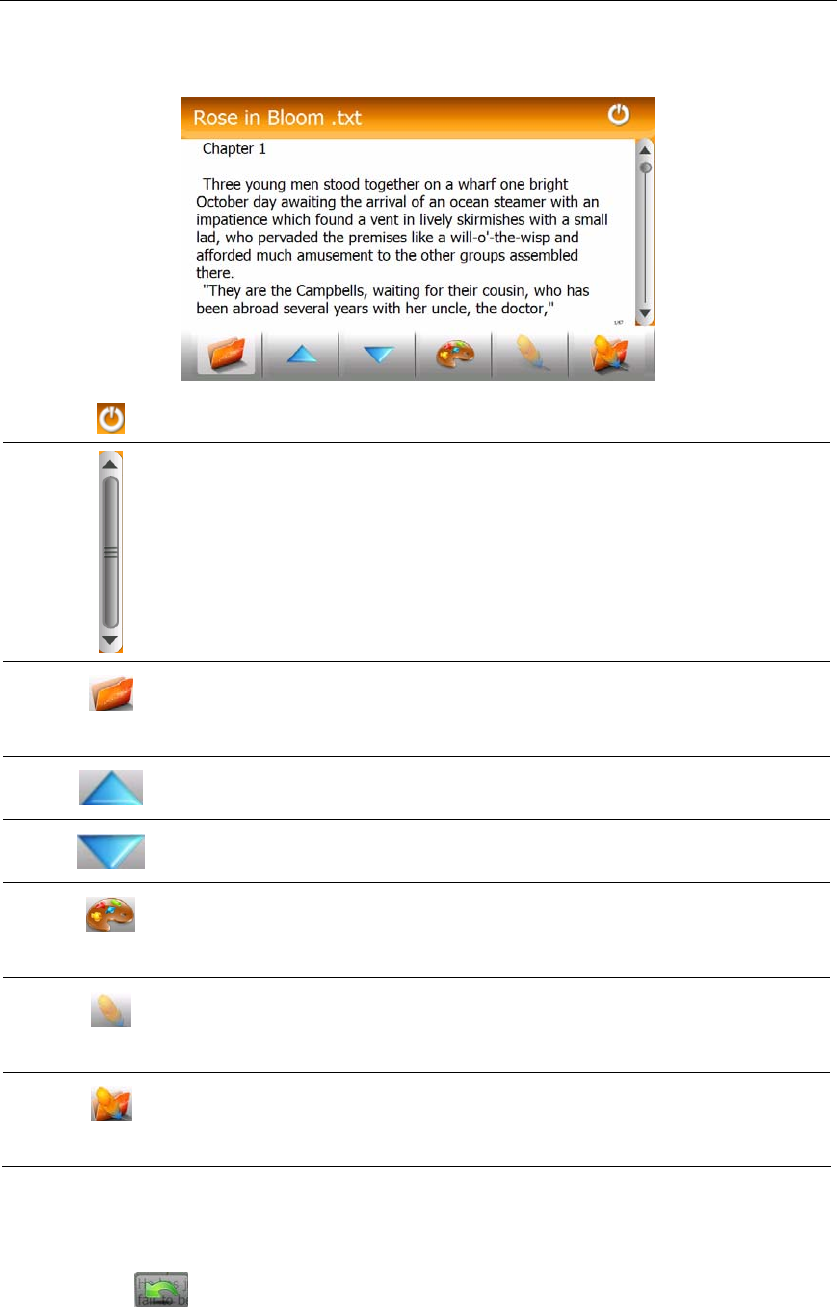
Operation Instruction
17
Select a book file and tap it to enter the reading interface as follow:
Close Close the reader.
Scroll bar Drag the sliding block upward/ downward to
view all content of the e-book.
Folder Enter the e-book folder to select an e-book to
read.
Previous Read the previous page.
Next Read the next page.
Setting Select a text theme, font, word size and bold
type.
New
bookmark
Select partial text and tap the icon to create a
bookmark.
Bookmark
list
Enter the bookmark list to select or delete a
bookmark.
4.4.2.1 Full Screen Reading
In the above interface, double tap the screen to enter to the full screen reading mode
as follow, tap to quit.
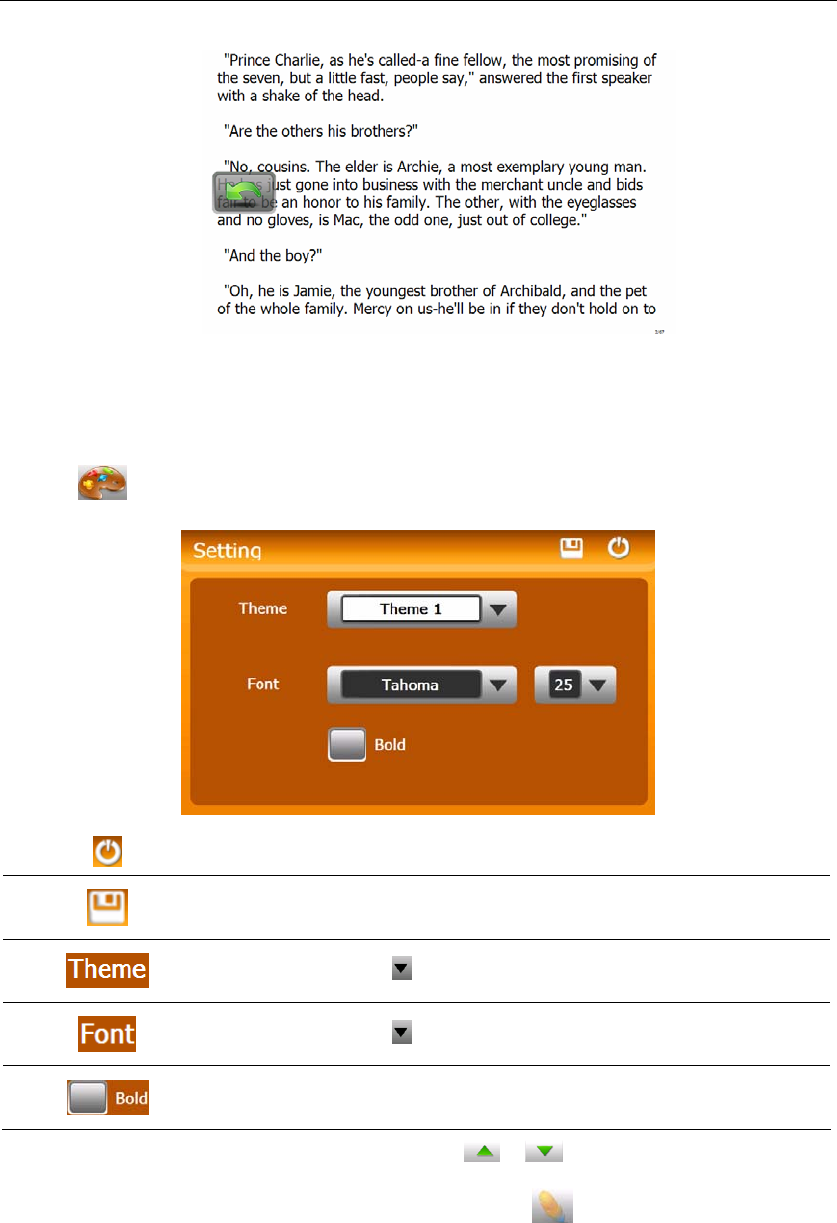
Operation Instruction
18
4.4.2.2 Creating and Viewing Bookmark
Tap in the e-book reader interface to enter the setting interface shown as below.
Close Exit the setting interface
Save Save the setting.
Theme Tap to select a theme for the e-book.
Font Tap to select a font for the e-book.
Bold Tap to enable bold type. Tap it again to cancel.
To create a bookmark, locate a page by taping / or dragging the scroll bar in
the reader interface and drag to select text content. Tap to popup a dialogue box as
follow and then tap OK to finish.
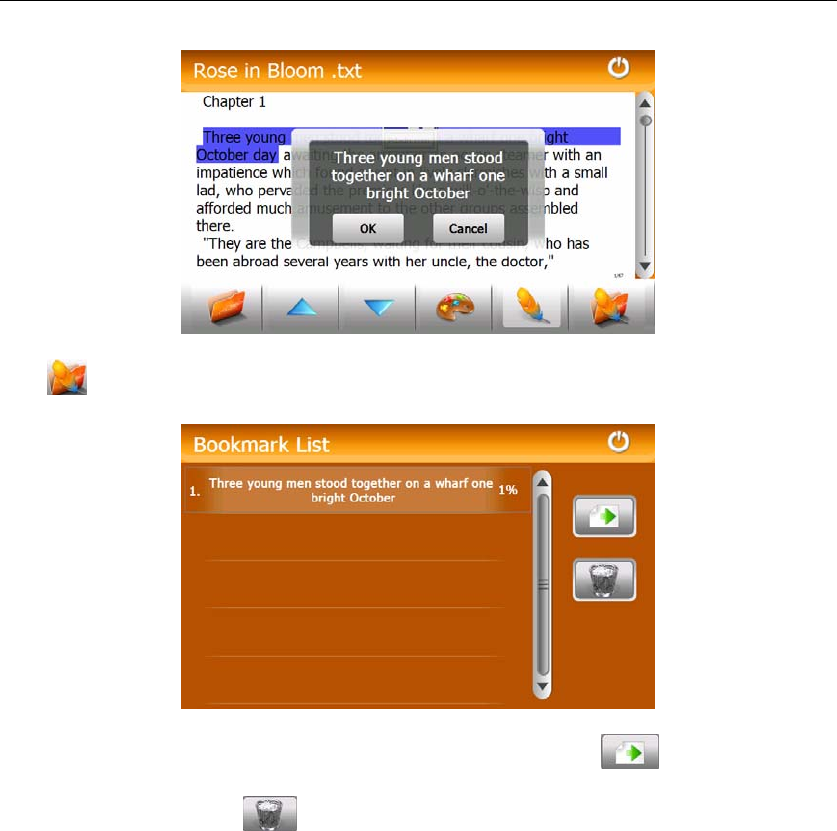
Operation Instruction
19
Tap to view created bookmarks in the interface of Bookmark List shown as below.
Drag the scroll bar and select a bookmark on the left list. Tap to go to the page
with the bookmark or tap to delete the bookmark.
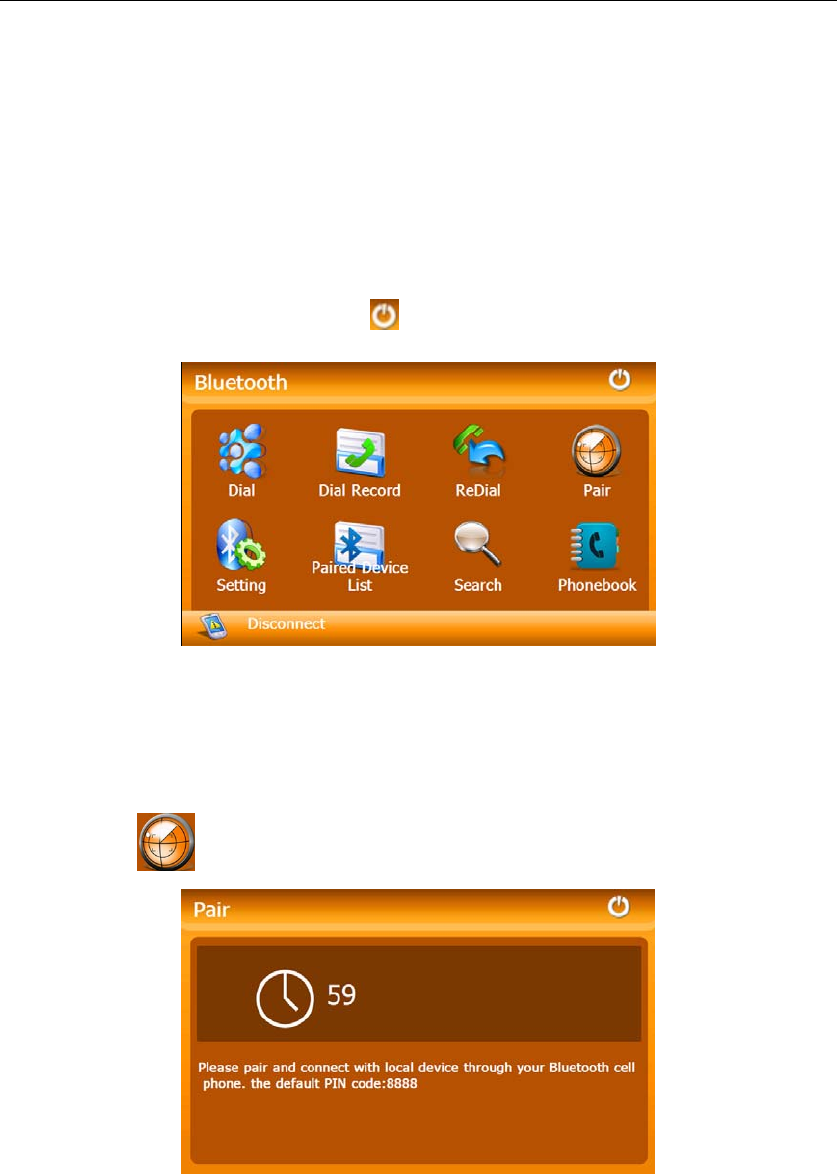
20
Chapter V Bluetooth
This function realizes wireless connection between the GPS navigator and a Bluetooth
mobile phone for making and answering calls. Before using this function, make sure that
Bluetooth function of the cell phone has been enabled.
Tap「Bluetooth」icon in the system main interface to enter the Bluetooth Interface as
follow. To quit the interface, tap the icon .
5.1 Pair
Pair the navigator and a mobile phone while setting up connection between them for the
first time. Tap in the Bluetooth interface to enter the following interface.
Meanwhile, press the icon “Search audio device” or similar one on the mobile phone. After
the mobile phone finds and display the name of the navigator (i.e. PND), tap “Connect”
and input the default PIN code: 8888. After pairing, the following interface will be displayed
with connection situation and mobile phone name on the bottom.
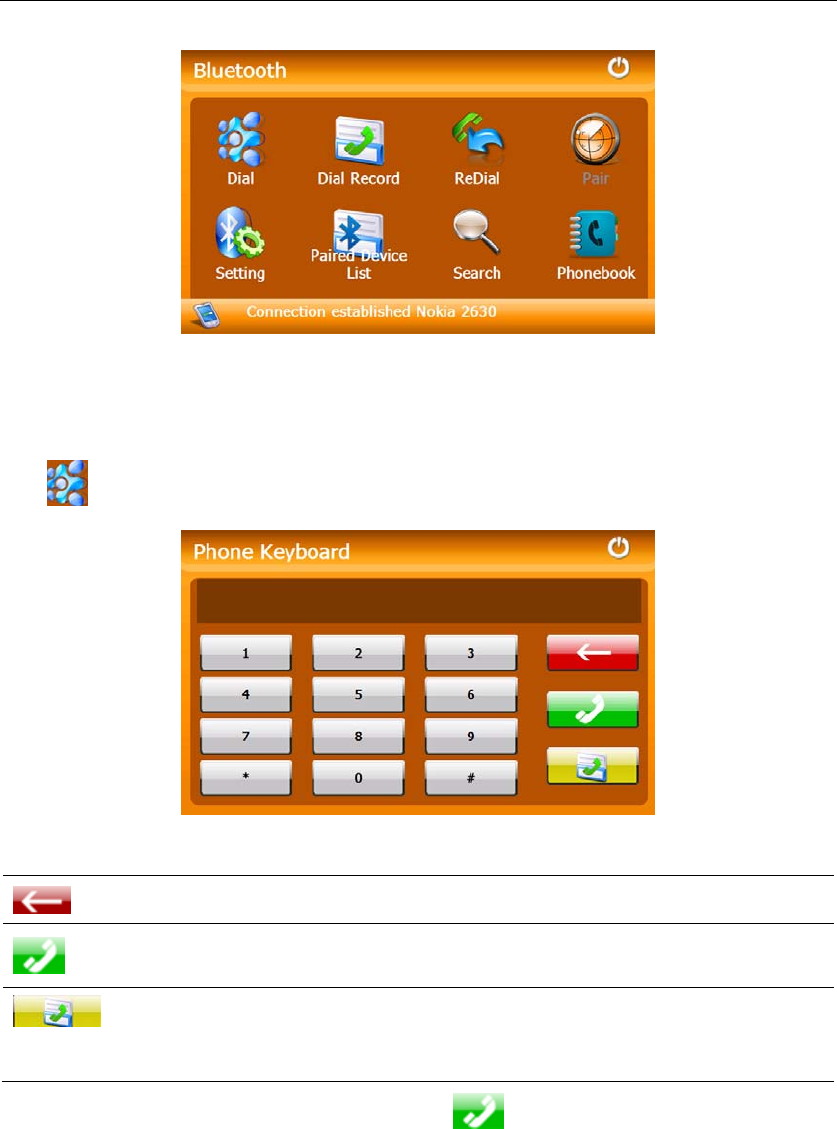
21
5.2 Making a Call
Tap on the Bluetooth interface to enter the keypad interface as shown below.
Icon Name Explanation
Backspace Delete the last input number or sign
Dial Dial the input number
Call records Check the answered call records, outgoing call records
and missed call records
To make a call, input the number to call and tap as shown below.
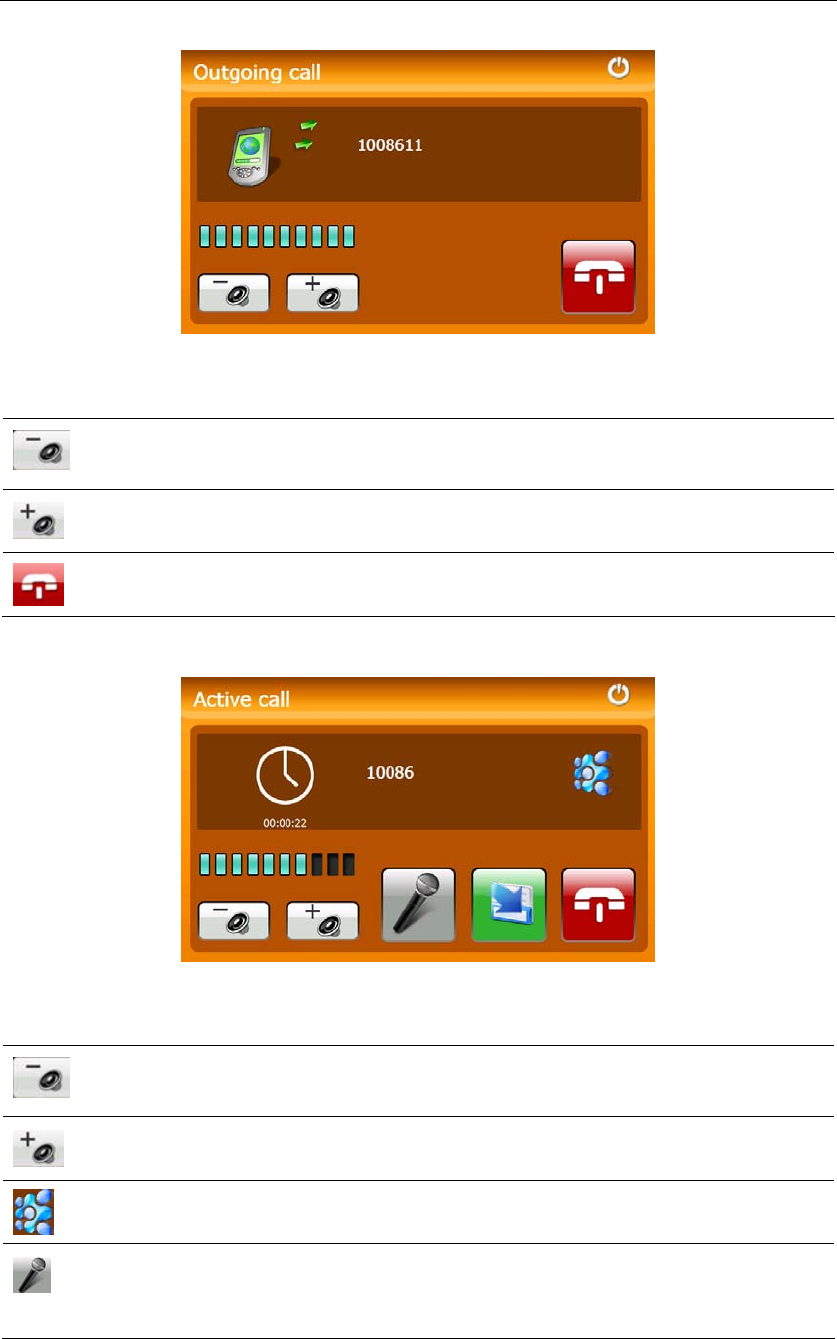
22
Icon Name Explanation
Volume down Reduce the volume
Volume up Increase the volume
Hang off End the call
After the call is put through, the following interface will be displayed.
Icon Name Explanation
Volume down Reduce the volume
Volume up Increase the volume
Keypad Open the keypad as shown in the following interface
Microphone Tap to stop audio input, and tap it again to resume
audio input.
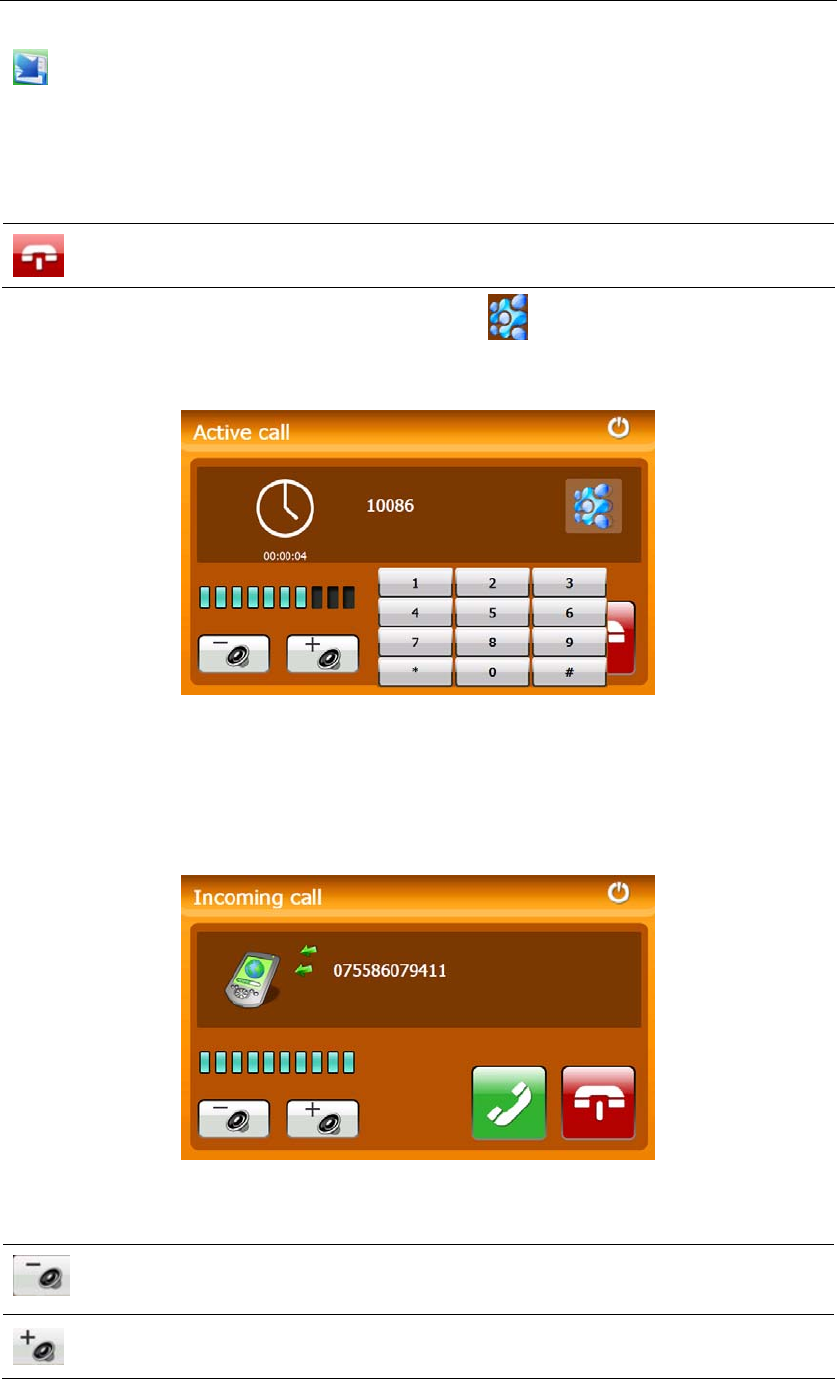
23
Voice switch Tap to switch the voice from the navigator to the
mobile phone; to switch the voice back to the
navigator, you may tap the “hands free” or similar icon
on the mobile phone.
Hang off Hang off the call
To input numbers or other content during a call, tap in the above interface to display
the keypad as shown below. To hide the keypad, tap the icon again.
5.3 Answering a Call
When there is an incoming call, the following interface will be displayed.
Icon Name Explanation
Volume down Reduce the volume
Volume up Increase the volume
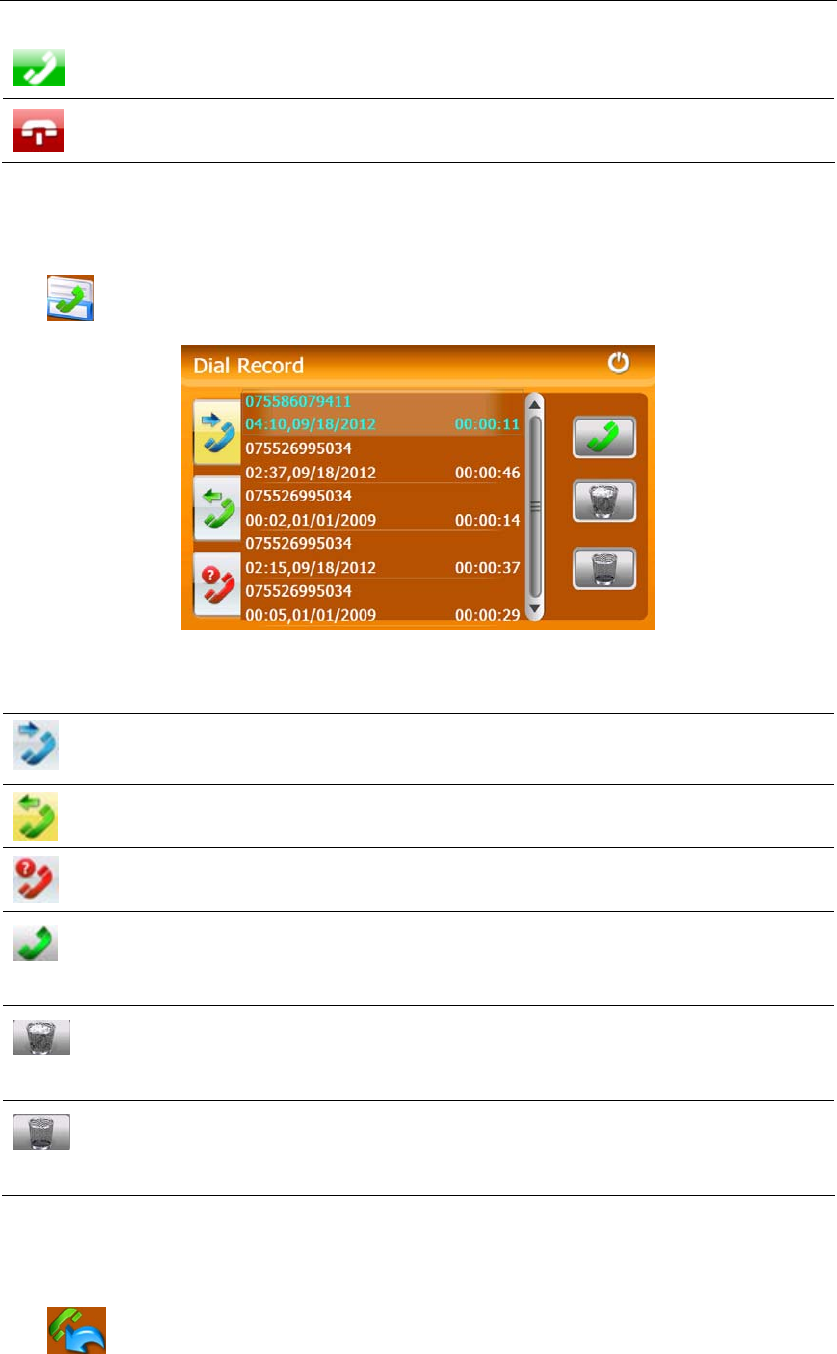
24
Answer Answer the call
Reject Reject the incoming call
5.4 Dial Record
Tap in the Bluetooth interface to enter the call records interface as shown below.
Icon Name Explanation
Incoming call records Tap it to view the list of incoming call numbers.
Outgoing call records Tap it to view the list of called numbers.
Failed call records Tap it t to view the list of failed calls.
Generate Select a number in the list and tap this icon to
generate a call.
Delete one Select a number in the list and tap this icon to
delete it.
Delete all Select all the numbers in the list and tap this
icon to delete it.
5.5 Redial
Tap in the Bluetooth interface to redial the latest dialed number and display the
call interface. Refer to 5.2 Making a Call for detailed operation.
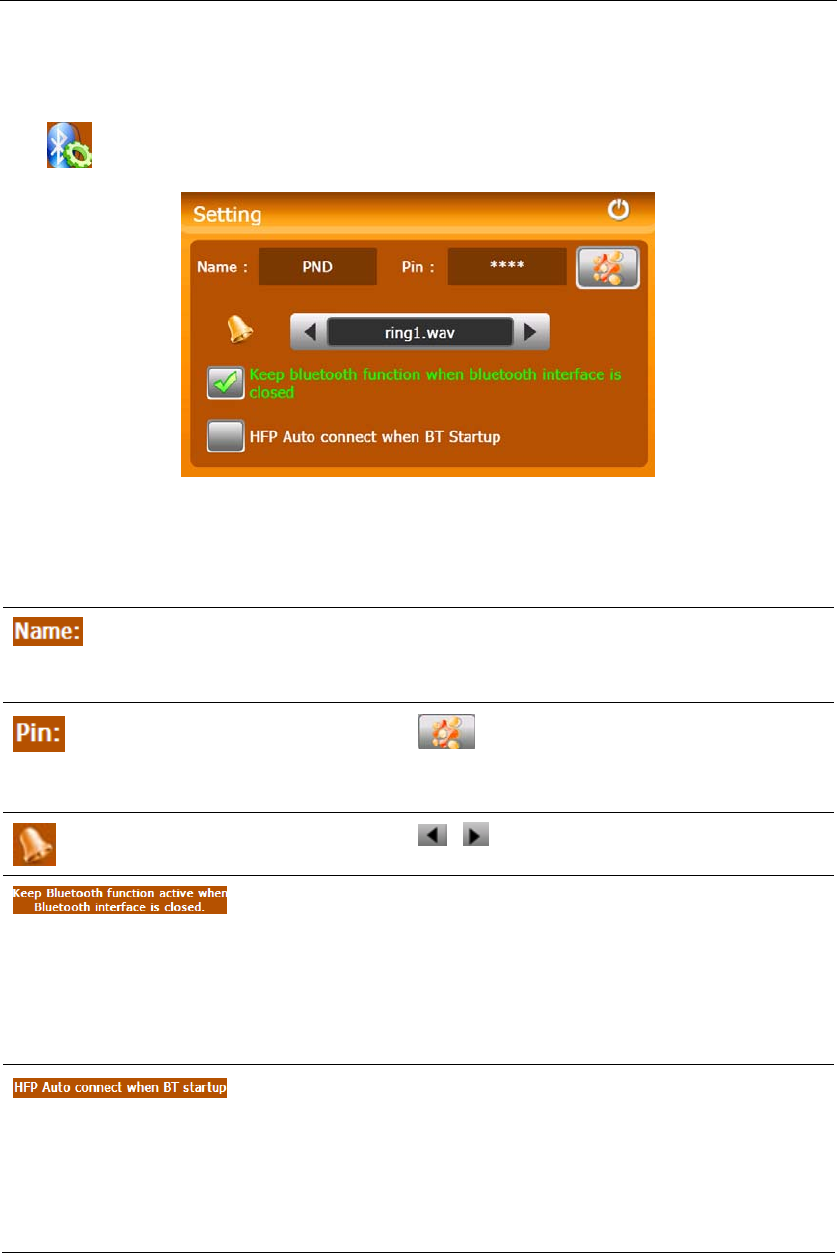
25
5.6 Setting
Tap in the Bluetooth interface to enter the setting interface as shown below.
Icon Name Explanation
Name The device’s display name in the Bluetooth
transmission process.
Pin code Tap to set a pin code for the connection
between the PND and mobile phone.
Ring Tap / to select a ring tone.
(Optional) If this item is selected, Bluetooth function
remains enabled when the Bluetooth interface is
closed. Otherwise, Bluetooth function will be
disabled.
(Optional) If this item is selected, the system will generate
auto hands-free profile between the navigator
and the mobile phone when Bluetooth is
restarted.
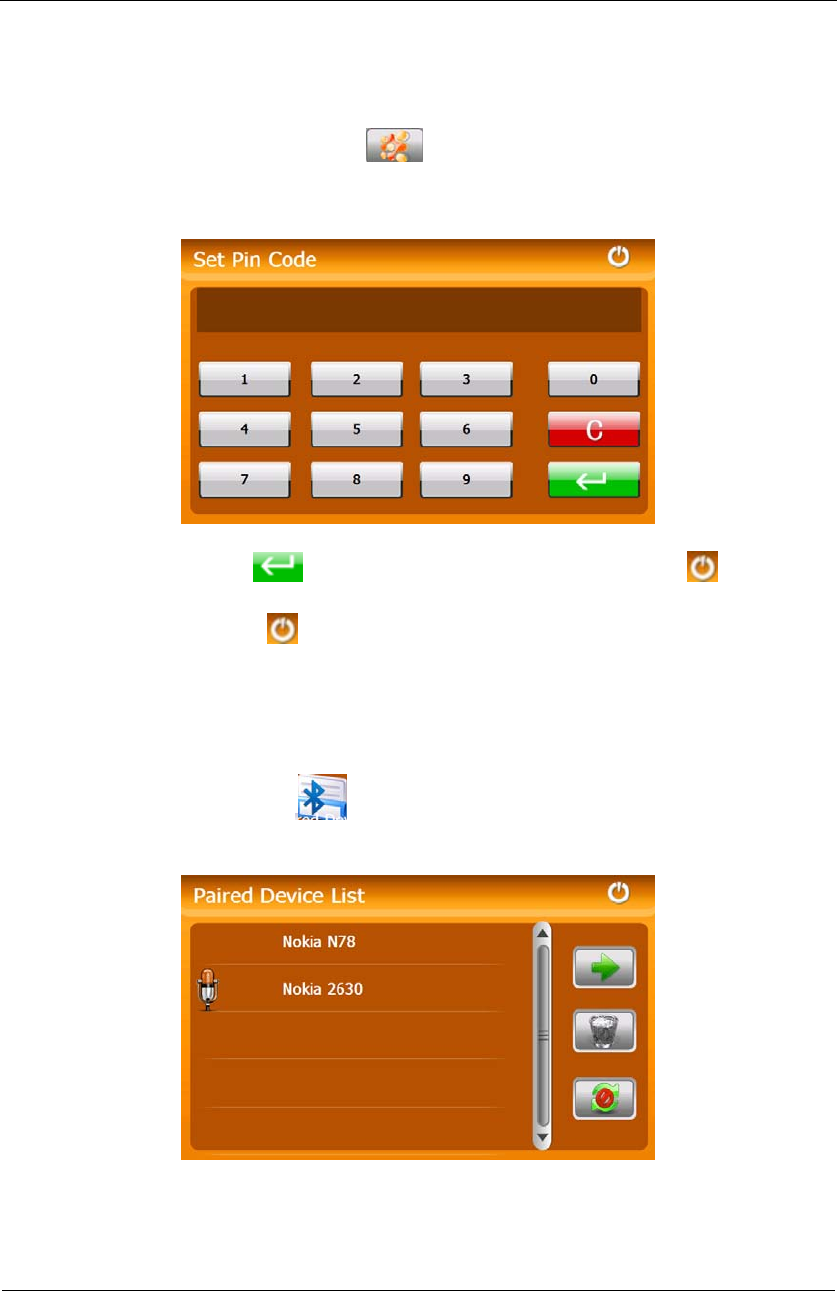
26
5.6.1 Modify Bluetooth Pin Code
To modify the Bluetooth PIN code, tap in the above interface to enter the following
interface.
Input a new PIN code, tap to return to the setting interface and tap to finish. To
cancel the modification, tap to return to the setting interface and tap it again to quit.
5.7 Paired Device List
In the Bluetooth interface, tap to enter the Paired Device List interface as shown
below.
Icon Name Explanation
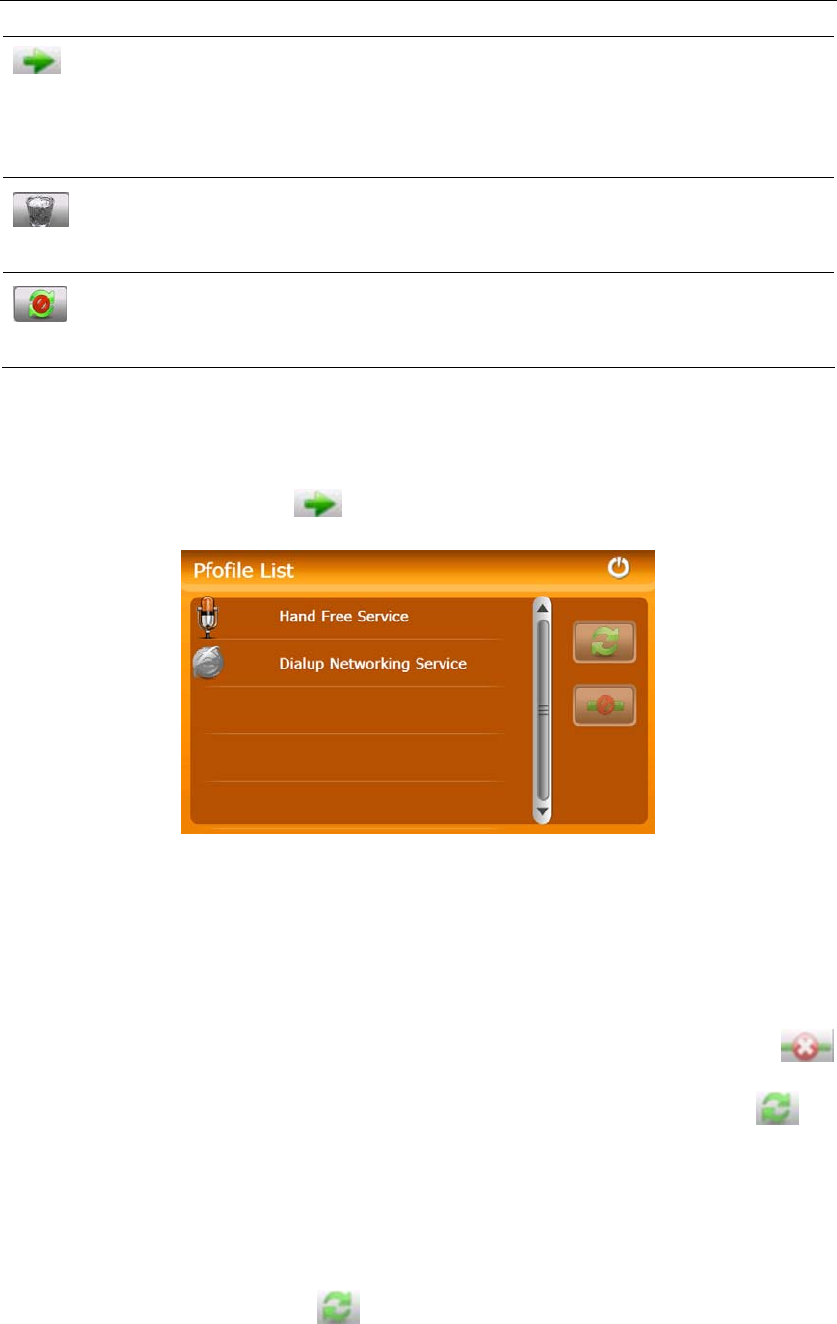
27
Profile list Select a paired device from the list on the left and
tap this icon to view the profile list as shown in the
following interface.
Delete one Select a paired device and tap this icon to delete the
device.
Disconnect Select a paired device and tap this icon to
disconnect the navigator from the device.
5.7.1 Profile List
Select a paired device and tap to view the profile list of this device as shown below.
[Note]: Profile details may differ for different mobile phone.
5.7.1.1 HFP
Select a service from the Profile List and tap the highlighted icon on the right. If the
navigator is in connection with the mobile phone, tap “Hand free service” and then
to disconnect; if the navigator is not connected with the mobile phone, tap for
connection.
5.7.1.2 Dial-Up Network Service
Select DUN service and then tap to enter the DUN interface as shown below.
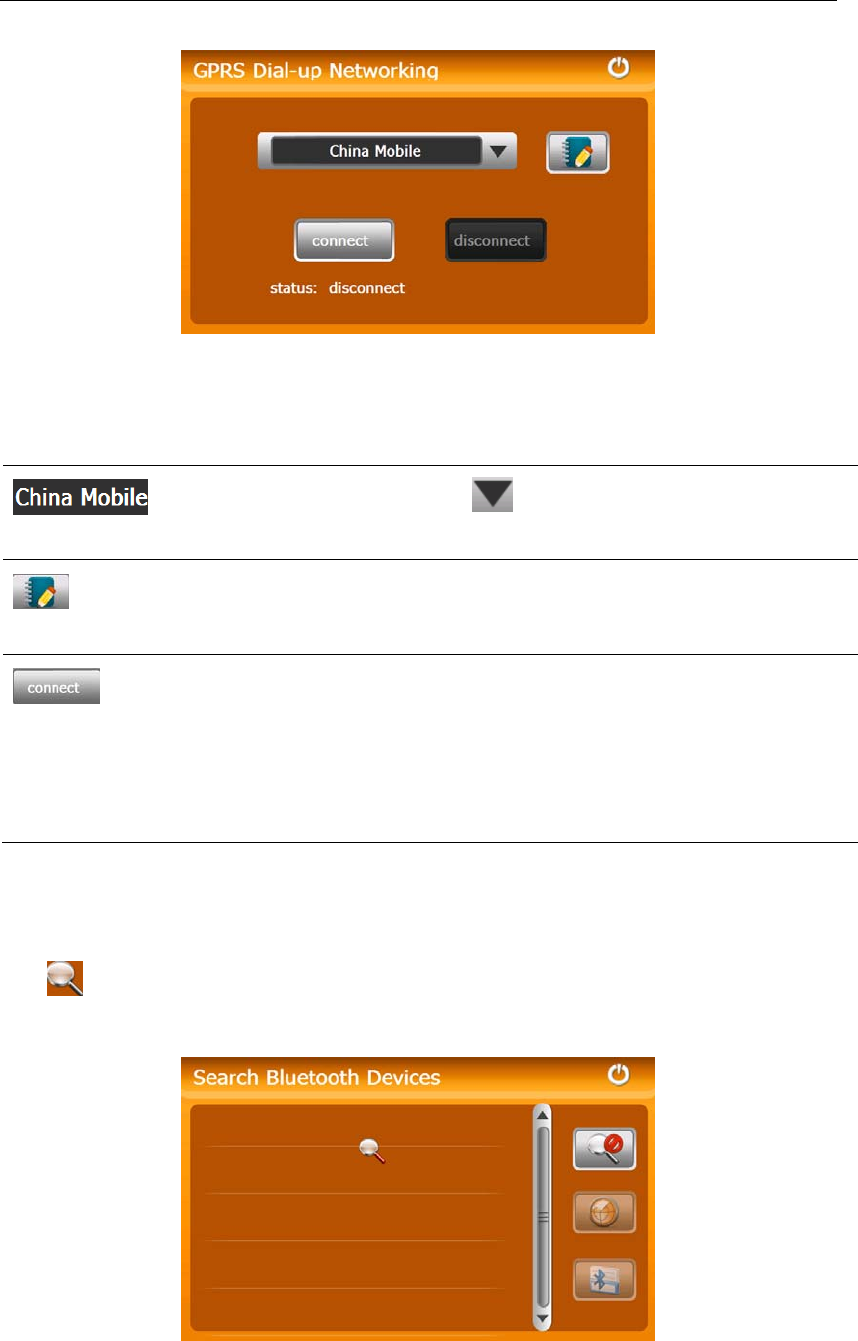
28
Icon Name Explanation
Service provider
name
Tap to select your service provider.
Service provider
information
Tap to add, modify or delete the information
of the selected service provider.
Connect to network Tap to establish DUN connection. After
connection, you may enter the WINCE
interface to use Internet Explorer for web
browsing and downloading.
5.8 Search Bluetooth Device
Tap in the Bluetooth interface to enter the Search Bluetooth Device interface for auto
Bluetooth device search and display as shown below.
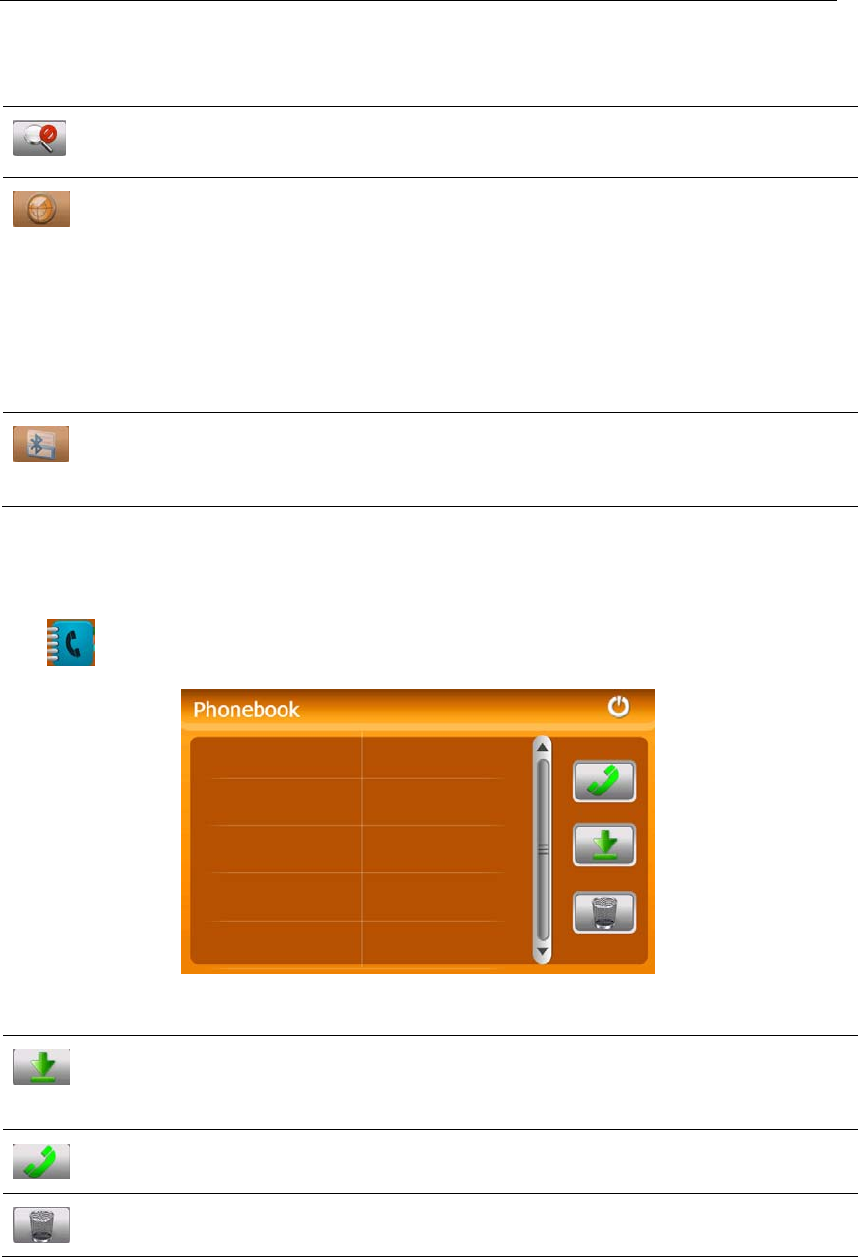
29
Icon Name Explanation
Stop Stop searching for Bluetooth devices.
Pair After selecting a Bluetooth device, tap the icon to
pair the navigator and the mobile phone. The default
PIN code “8888” Shall be input. After connection,
the Profile List of the device will be displayed. Refer
to 5.7 Pair Device List.
Pair device
list
Tap to enter the Pair device list. Refer to 5.7 Pair
Device List.
5.9 Phonebook
Tap in the Bluetooth interface to enter the Phonebook interface as shown below.
Icon Name Explanation
Download Download the phonebook of the mobile phone to the
PND.
Dial Select a number from the phonebook and tap this
icon to generate a call.
Delete Select a number from the phonebook and tap this
icon to delete it.
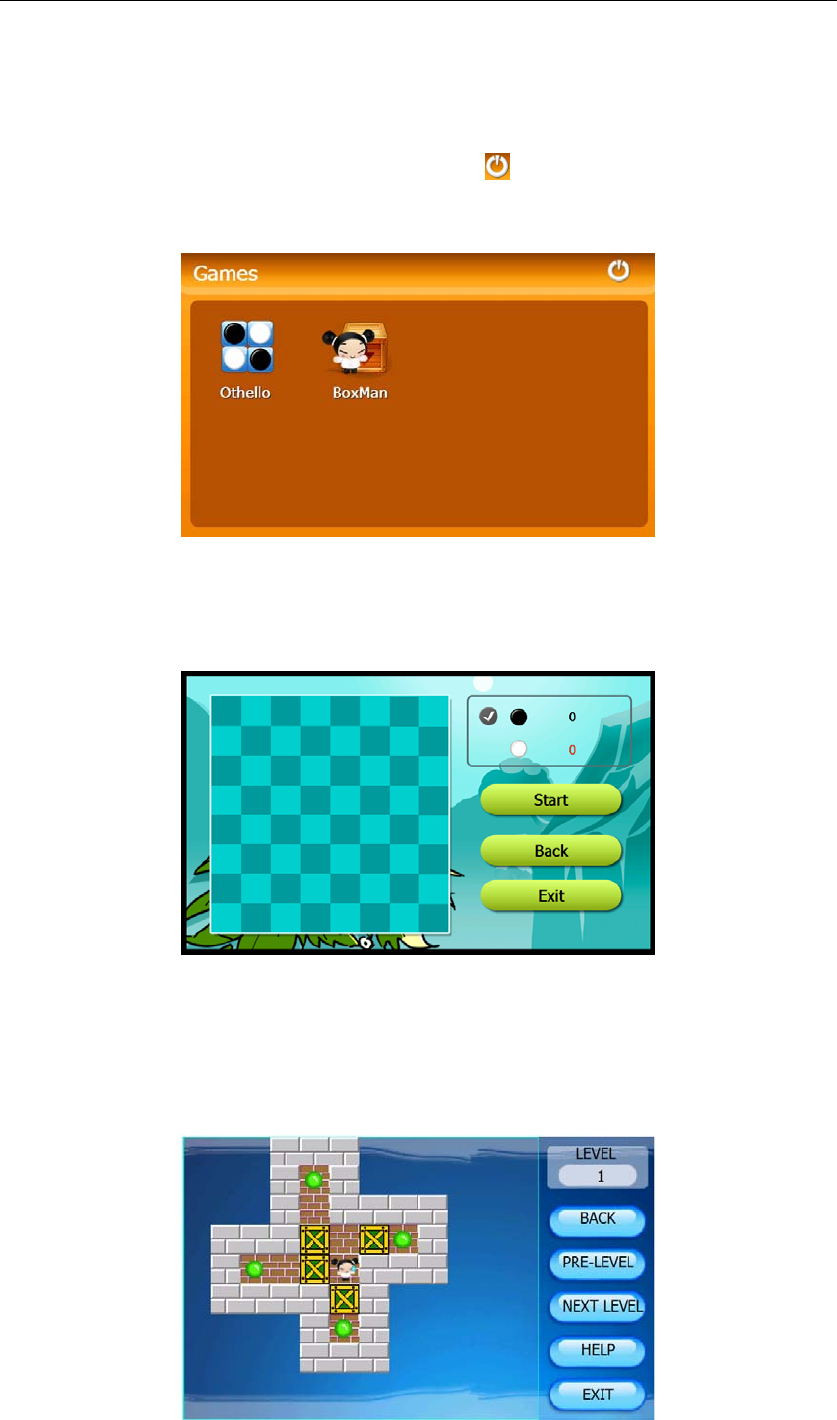
30
Chapter VI Games
This chapter introduces the usage of Games. Tap「Games」in the system main interface to
enter the games interface as shown as below. Tap to exit. Tap the game icon to start
to play games.
6.1 Othello
6.2 BoxMan
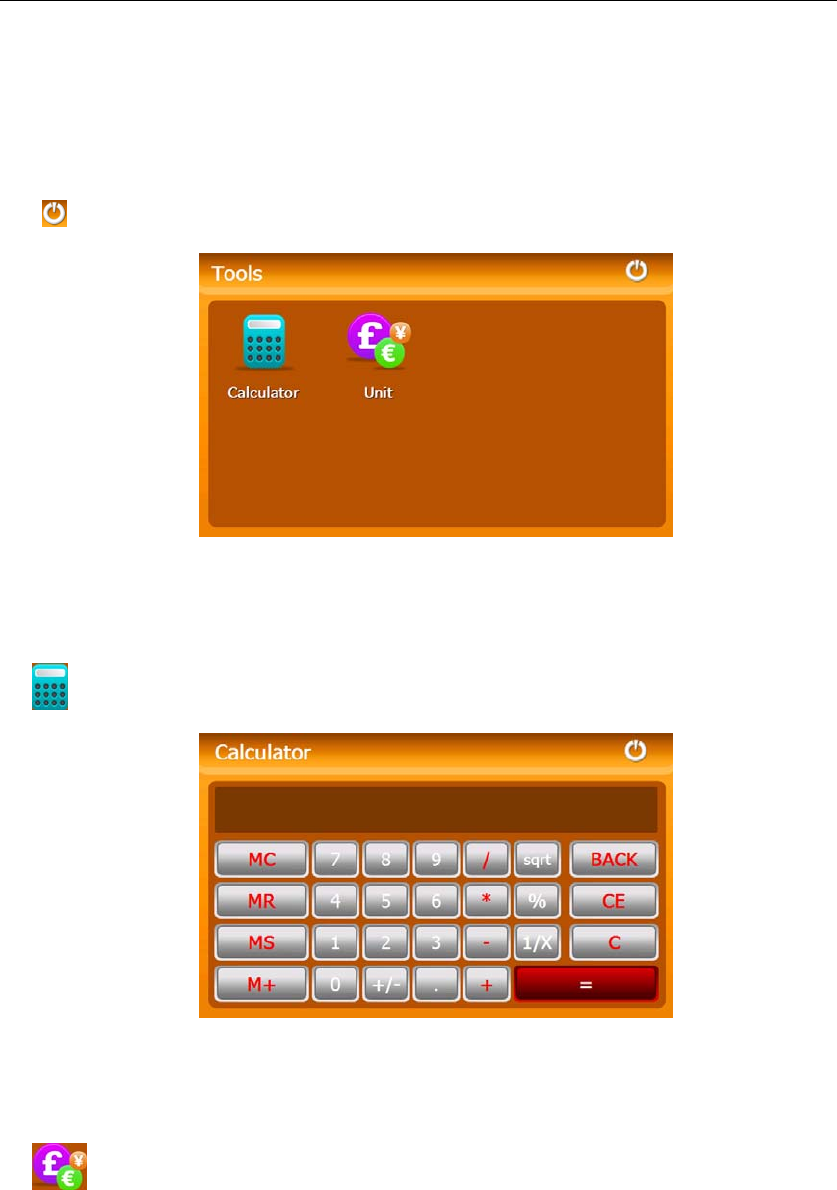
31
Chapter VII Tools
The tools include Calculator and Unit conversion.
Tap 「Tools」in the system main interface to enter the tools interface as shown below and
tap to exit.
7.1 Calculator
Tap in the tools interface to enter the calculator interface as shown below:
7.2 Unit
Tap in the tools interface to enter the unit interface as shown below:
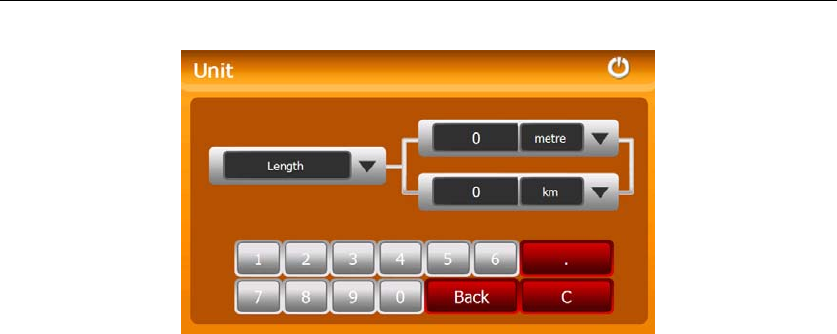
32
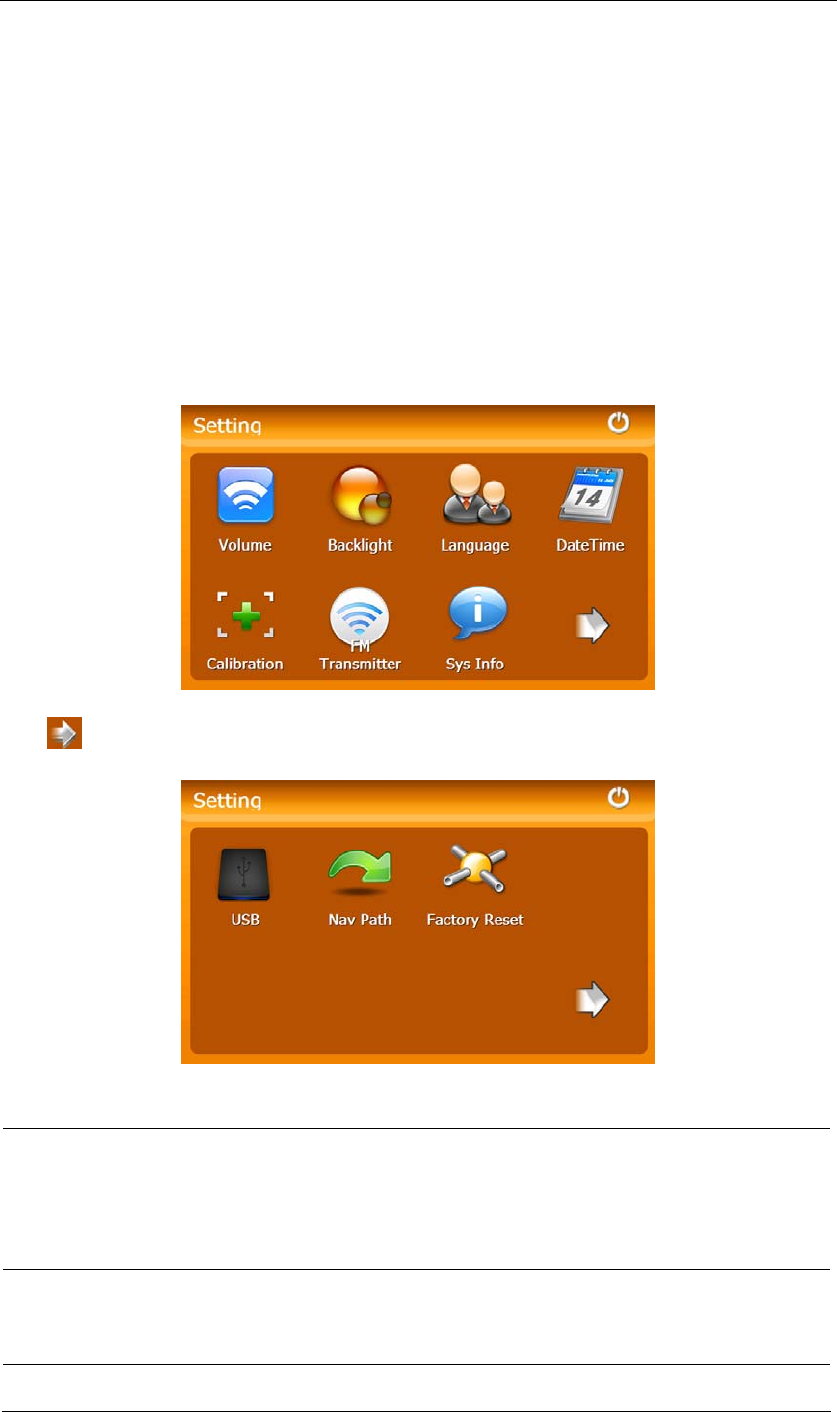
33
Chapter VIII Settings
8.1 Summary
This chapter introduces the system settings of the GPS navigator.
Tap the icon 「Setting」 in the system main interface to enter the system setting interface
as follow to set volume, backlight, language, date & time, calibration, factory reset, system
info, USB and navigation path.
Tap to display the next interface.
Function Explanation
Volume
Adjust the speaker volume;
Open/ close the tap sound
startup music setting
Backlight Adjust the brightness of touch screen backlight;
Latency of auto backlight turnoff under power supply.
Language System language selection
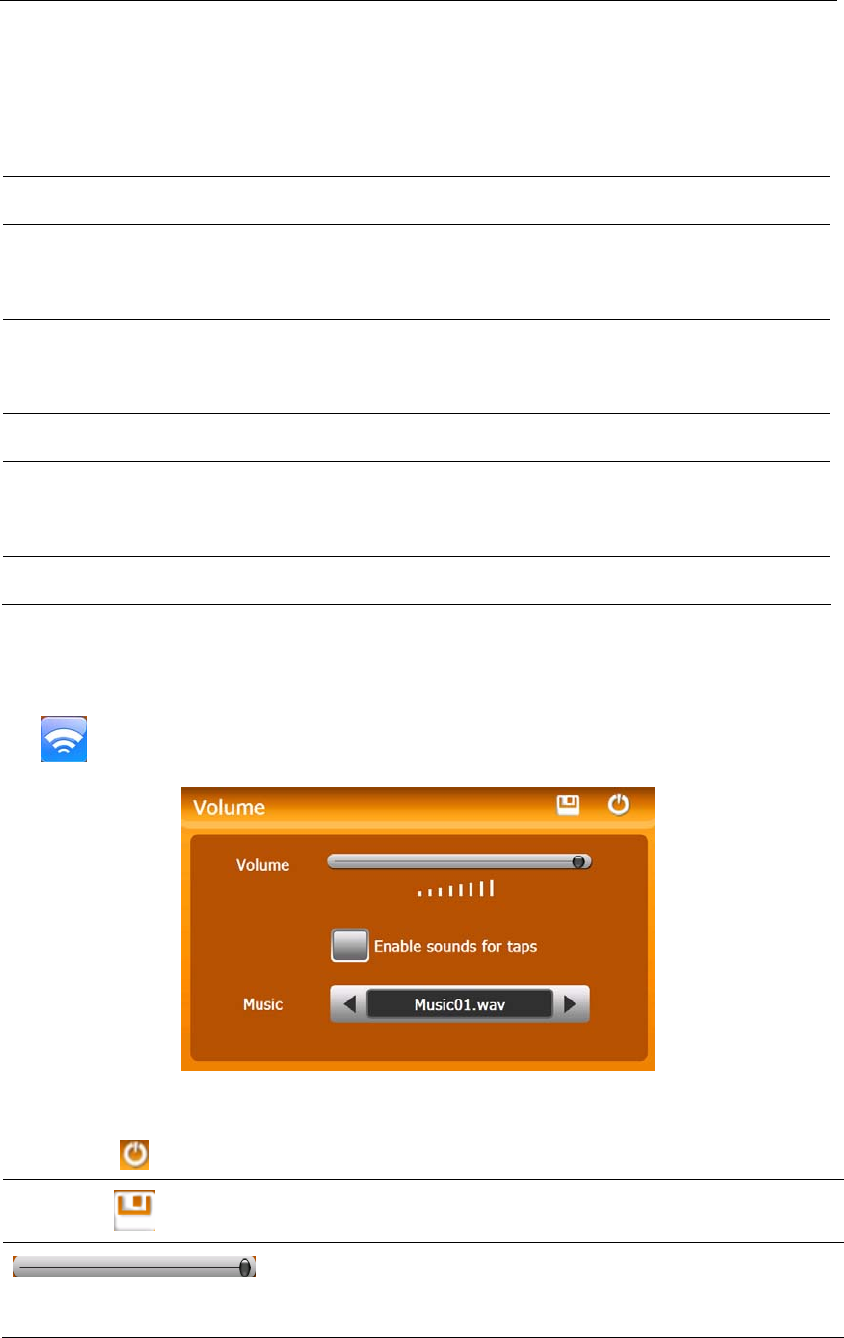
34
Date & time
System date setting;
System time setting;
System time zone setting;
Calibration If deviation occurs while touching the screen, calibrate the screen.
System info Display system information including ROM version, software version,
OEM version, platform ID and device ID.
FM
Transmitter Transmit audio signals of the navigator to radio sets.
USB setting Data transmission mode between the navigator and PC.
Navigation
path Select a document path for the navigator.
Factory Reset Reset the factory default settings.
8.2 Volume
Tap in the 「Setting」interface to enter the「Volume Setting」interface as shown below:
Close Exit the volume setting.
Save Tap to save the settings
Volume Drag the slider leftwards / rightwards to turn down /
up the volume
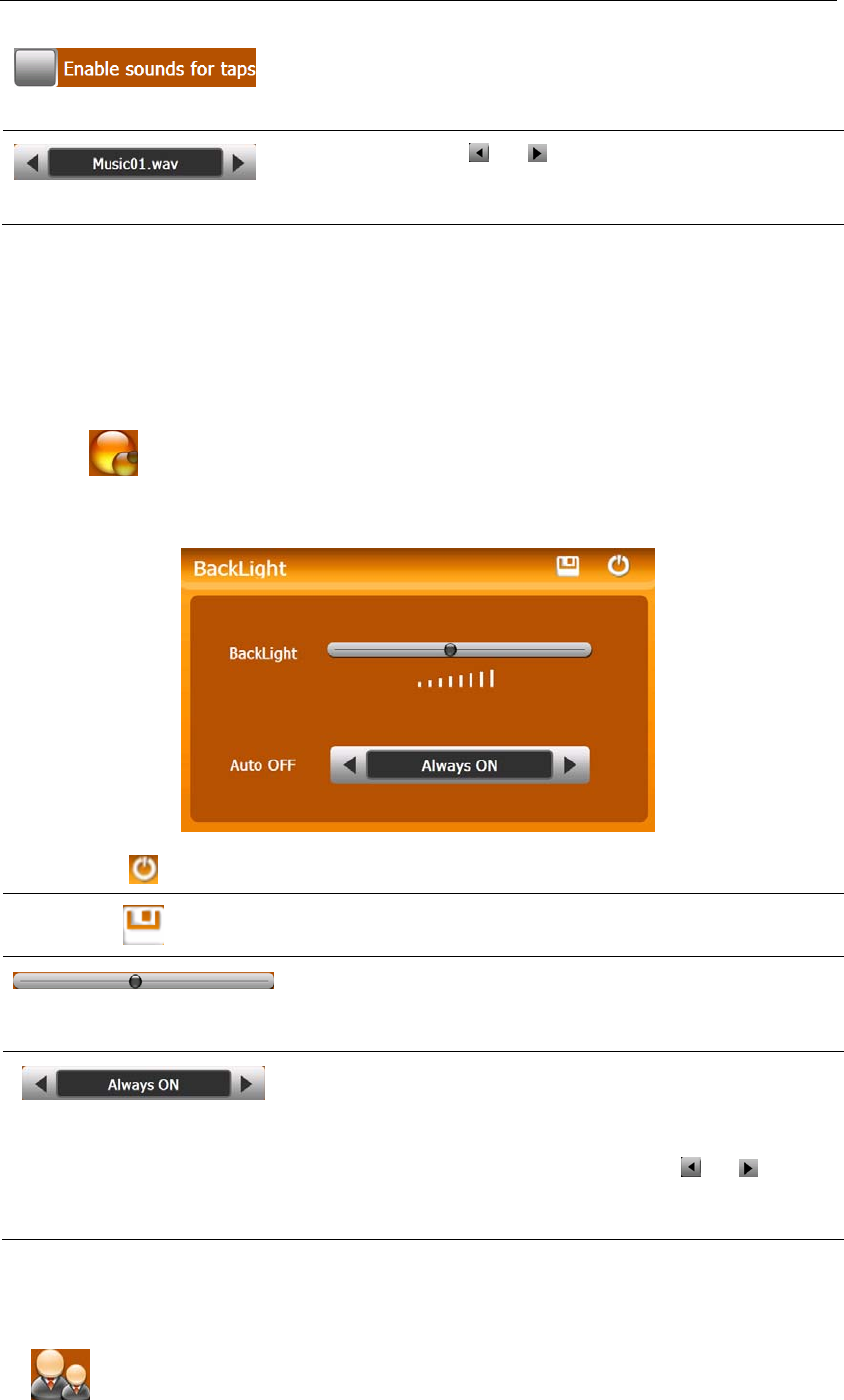
35
Sounds for
taps
Tap it to enable the function. Tap it again to
disable the function.
Power-on
music
Tap or to select power-on music or
disable it.
8.3 Backlight
Backlight setting includes backlight brightness adjustment and latency of backlight
off.
Tap in the「Setting」interface to enter the「Backlight Setting」interface as
follow:
Close Exit the backlight setting.
Save Tap to save the settings
Backlight Drag leftwards to turn down or rightwards
to turn up the backlight.
Auto off
Auto backlight shutoff after service stop for
a period. The options are always On, 10s,
30s, 1m, 2m and 3m. Tap or to view
the options in cycle or select one.
8.4 Language
Tap in the「Setting」interface to enter the「Language Setting」interface as follow:
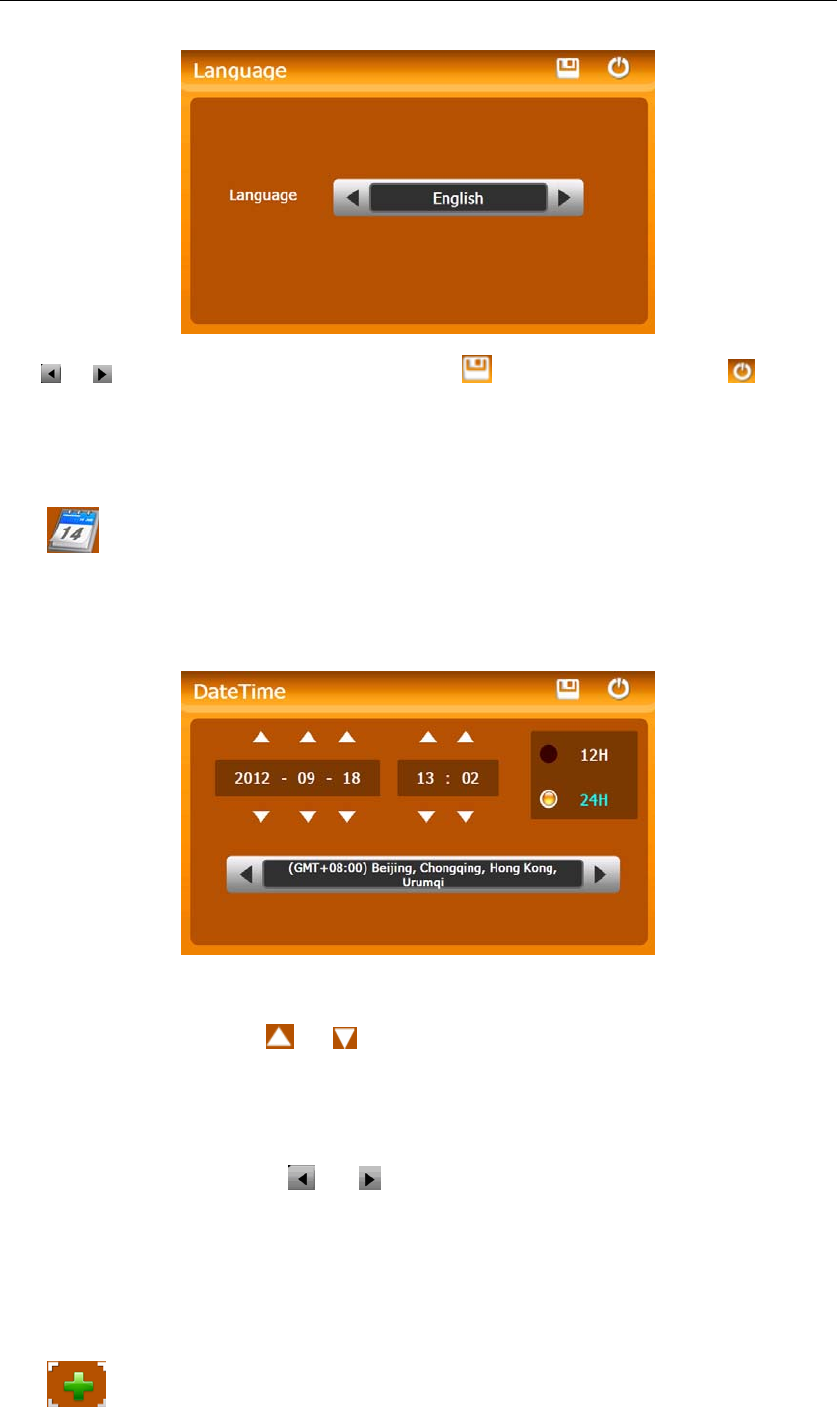
36
Tap or to select a system language, and then tap to save the settings and tap to exit.
8.5 Date& Time
Tap in the setting interface to enter the date and Time Setting interface as shown
below.
Date & Time setting includes system date setting, time setting and time zone setting.
8.5.1 Setting the system date and time
In the above interface, tap or to set the year, month, day, hour and minute.
[Note]: Time format options are 12-hour and 24-hour.
8.5.2 Setting the system time zone
In the above interface, tap or to select a time zone. For example, select
“(GMT+08:00) Beijing, Chongqing, Hong Kong, Urumqi” for China.
8.6 Calibration
Tap in the 「Setting」 interface to popup the calibration dialog as follow:
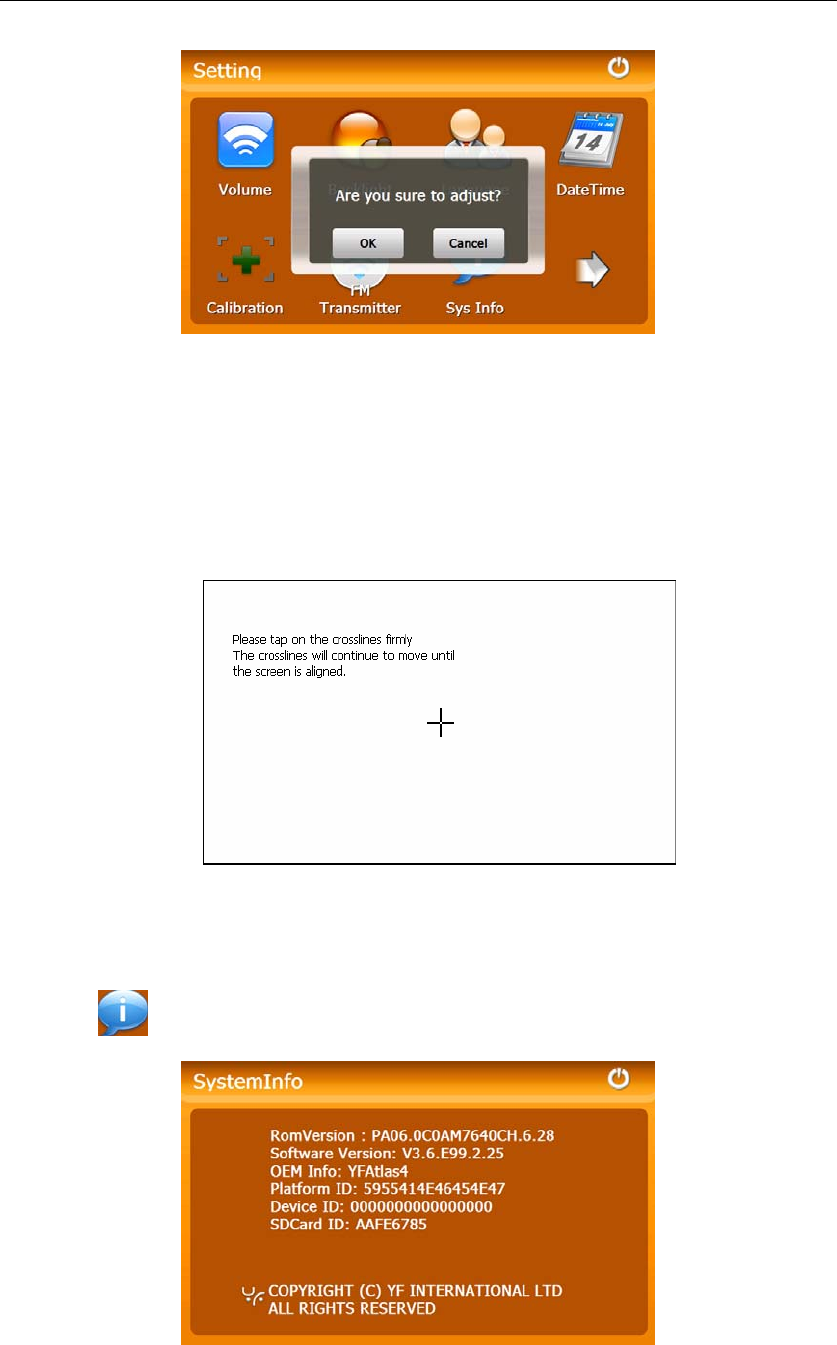
37
Tap OK to execute calibration or Cancel to cancel calibration and go back to the setting
interface.
Tap OK, and the following calibration interface is prompted. Click the center of cross cursor
with the stylus and the cursor shifts from the center, upper left, lower left, upper right and
lower right to finish the calibration and the interface will be closed automatically to go back
to the setting interface.
8.7 System Info
Tap the in the「Setting」interface to enter the System Information interface as follow:
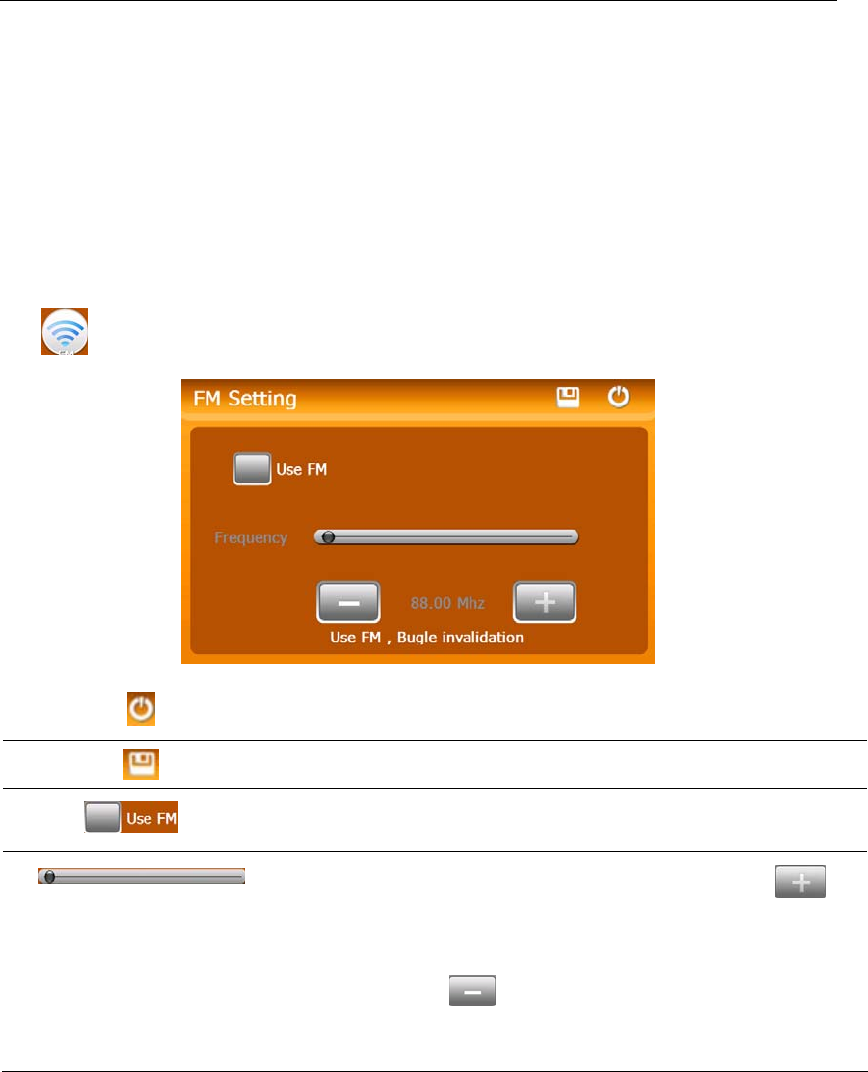
38
8.8 FM Transmitter
FM transmitter realizes transmission of audio signals of the GPS navigator to radio sets.
Adjust the emission frequency of the GPS navigator the same as that of the receiving
frequency of the radio, and sounds of the navigator will be output by the amplifier system
of the radio sets.
Tap in the 「Setting」interface to enter the「FM Setting」interface as follow:
Close Exit the FM Setting.
Save Save current setting.
⒑ Use FM Tick in the box to enable FM function.
Frequency Drag the slide block rightwards (or tap ) to
increase the frequency and leftwards (or
tap ) to reduce the frequency. The
frequency range is 76.00 Mhz-108.00 Mhz.
8.9 USB Setting
Connect the GPS navigator to PC via the MINI USB port to transmit data, or back up data
from the navigator data to PC.
The GPS navigator provides MASS STORAGE and MS STORAGE modes. Select one in
the USB setting.
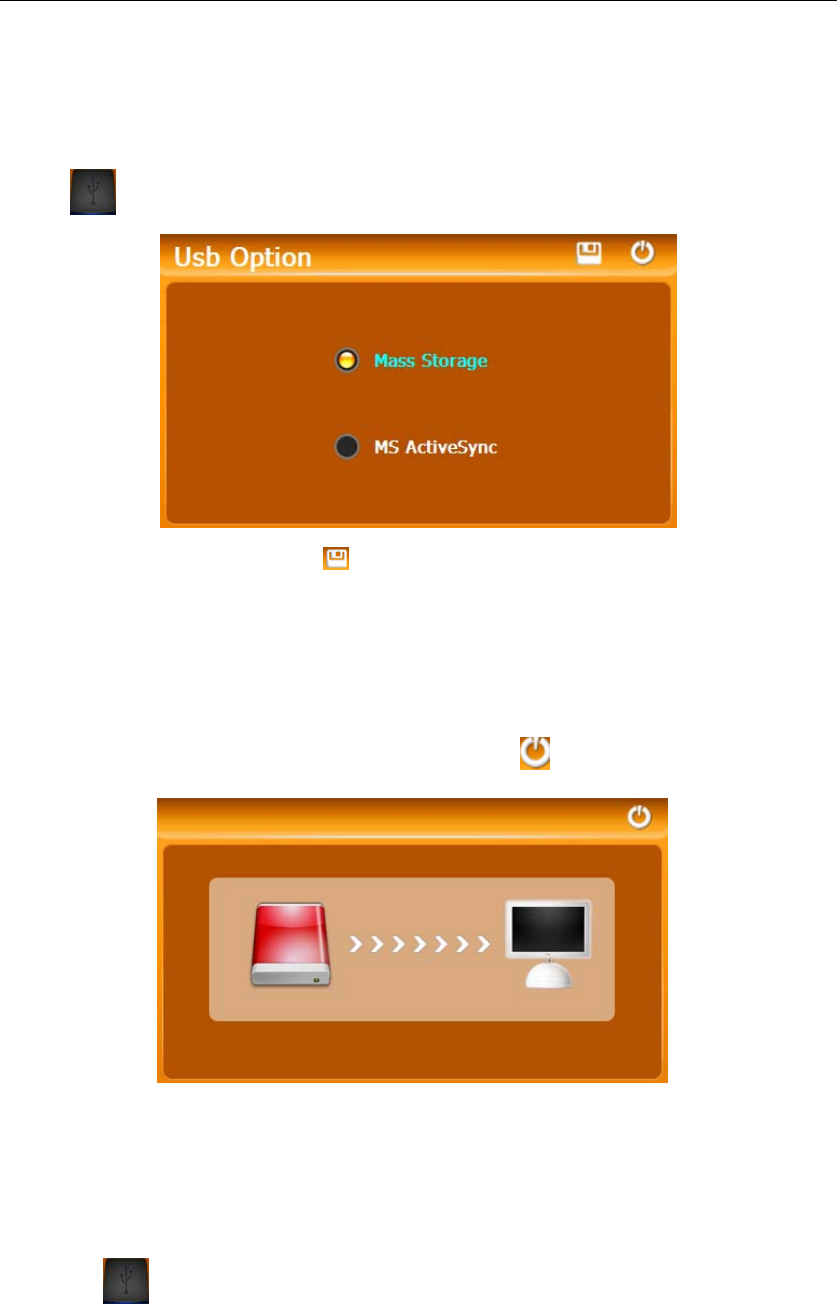
39
8.9.1 MASS STORAGE
1. Have the GPS navigator in operation status and the SD card plugged in the slot;
2. Tap in the system setting interface to enter USB Option as shown below.
Select MASS STORAGE and tap to save it.
3. Connect the MINI USB terminal of the USB cord to the MINI USB port of the GPS
navigator and the standard USB terminal to the USB Host port of PC. Then the PC will
recognize the navigator and prompt the following interface. To disconnect the navigator
from PC and enter USB charging mode, you may select .
2
4. After communication, unplug the MINI USB cable.
8.9.2 MS ACTIVESYNC
1. Tap in the system interface to enter USB Option as shown below.
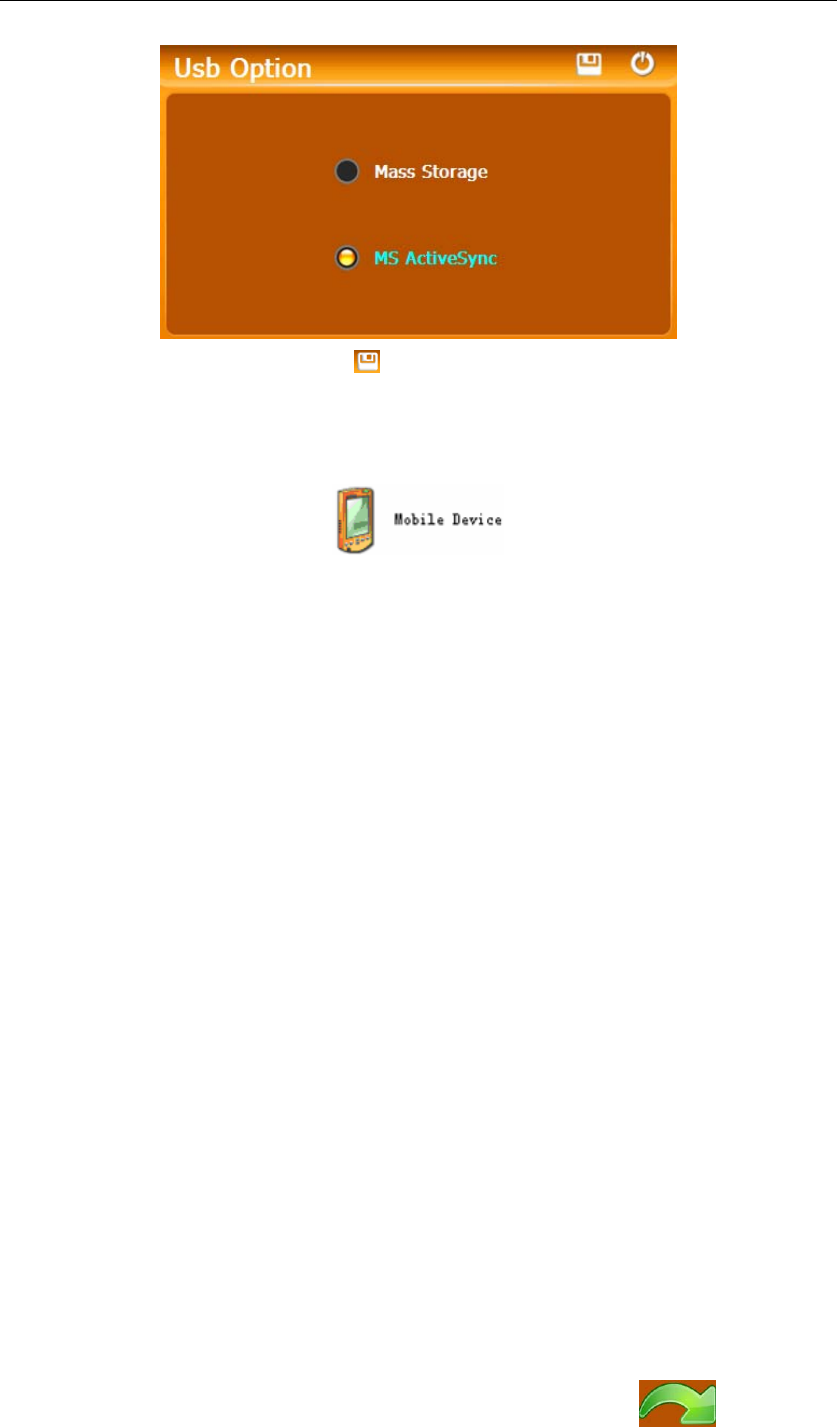
40
Select MASS ACTIVESYNC and tap to save the setting.
2. Install the application Mobile Device in a drive of PC. Then the following icon will
appear in the drive selection.
3. Connect the MINI USB terminal of the USB cable to the MINI USB port of the GPS
navigator and the standard USB terminal to the USB Host port of PC.
4. After the PC finds new hardware, double click the Mobile Device drive in the selection
area to enter the memory of GPS navigator for data transmission.
5. After transmission, unplug the USB cable.
[Attention] For data safety back up the navigator data. We assume no responsibility for
data loss or damage
[Note] If MASS STORAGE is selected while the GPS navigator is connected with PC,
other operations will be suspended.
[Attention] The following operations will stop suspend the communication of the system
and PC and unsaved data will be lost.
1. Unplugging the MINI USB cable;
2. Powering off the GPS navigator;
3. Resetting the system;
4. Tap the on close button on the top right.
8.10 Navigation Path
Insert a T-flash card with map data into the GPS navigator and tap to enter the
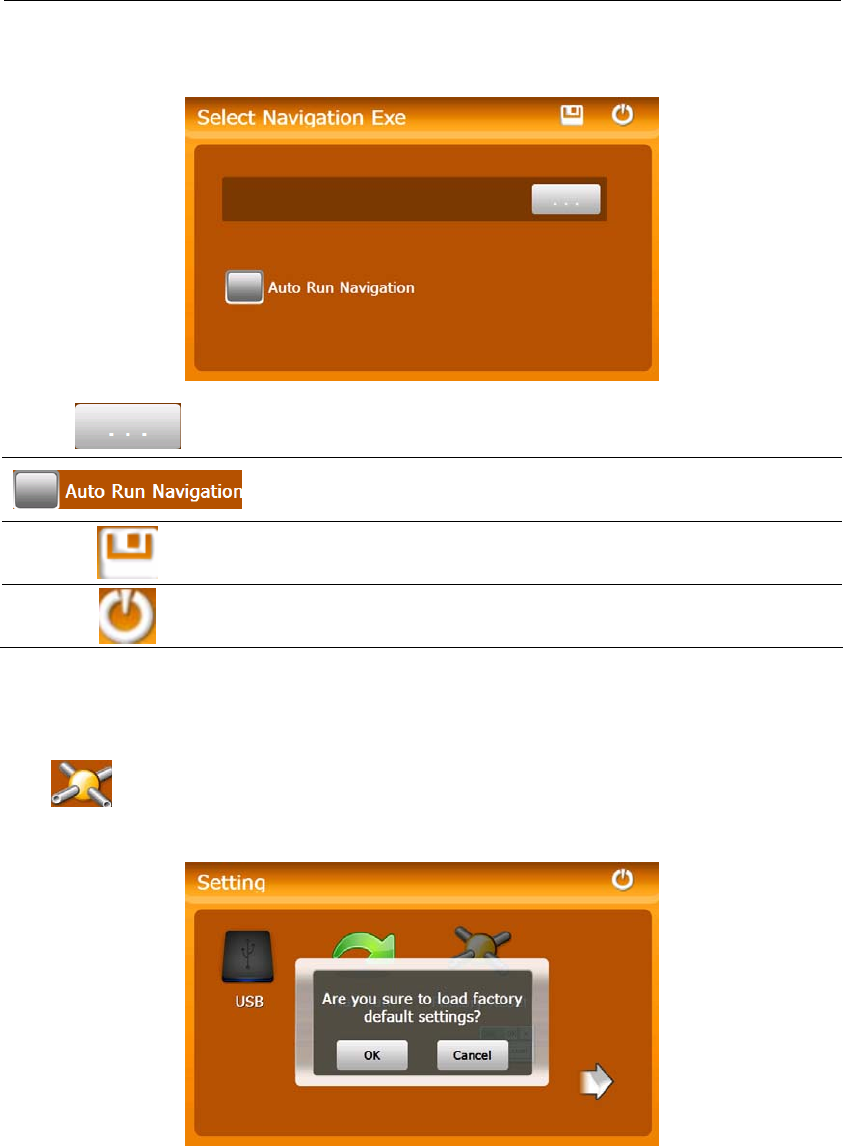
41
interface shown as below.
Tap to select a map address.
Tick in the box to run the set navigation map when the
navigator is powered on.
Tap to save the settings
Tap to exit
8.11 Factory Reset
Tap in the system interface to restore the factory setting. The following dialog will
be prompted.
Tap OK to restore the default setting or Cancel to return to the setting interface.
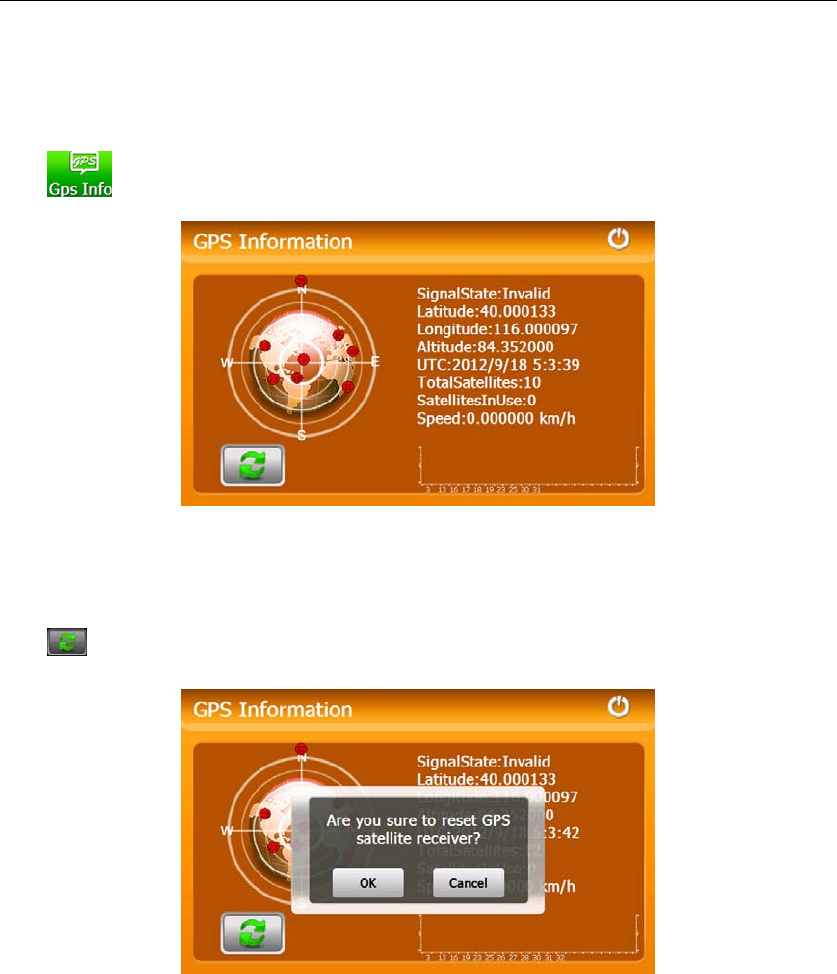
42
Chapter IX GPS Info
Tap in the system main interface to view the GPS information as shown below.
In the above interface, it shows information on signal state, latitude, longitude, coordinated universal time,
number of satellites, valid satellites and its speed.
Tap to popup a dialog as follow:
Tap OK to reset the GPS satellite or tap Cancel to exit.
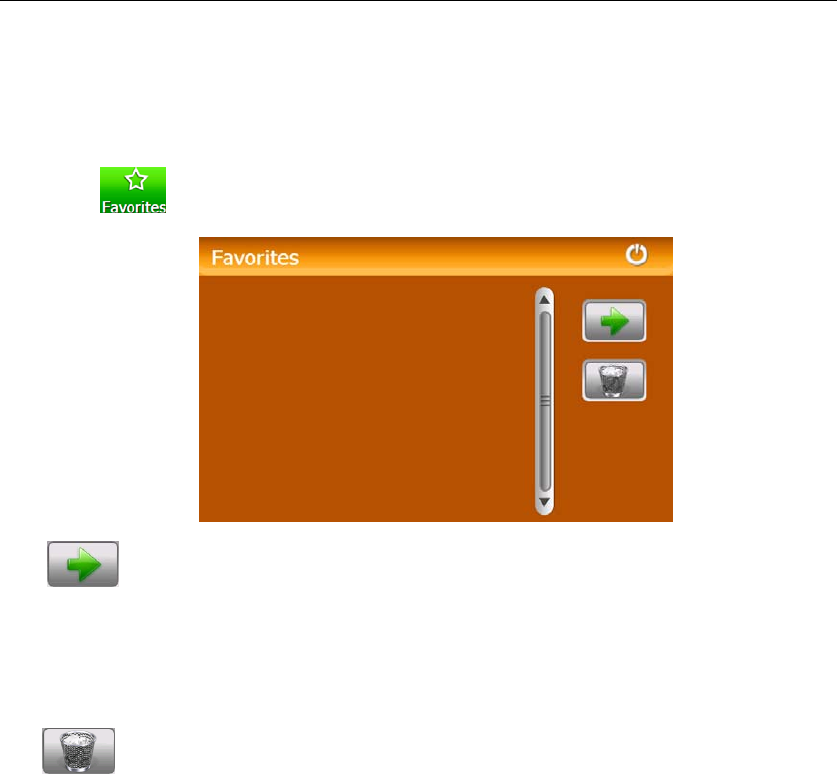
43
Chapter X Favorites
The function enables you to collect wanted applications that can be run under the WinCE
system with the.exe ending in its name.
Tap the icon in the system main interface to enter the following interface:
Tap in the above interface to open the directory where the application to be
added to (such as SDMMC or Resident Flash), and then double tap the application to add
it to the Favorite.
To delete applications from the Favorite, select the application in the above interface and
tap .
[Note]: While deleting the application, the shortcuts instead of application itself will be
deleted.
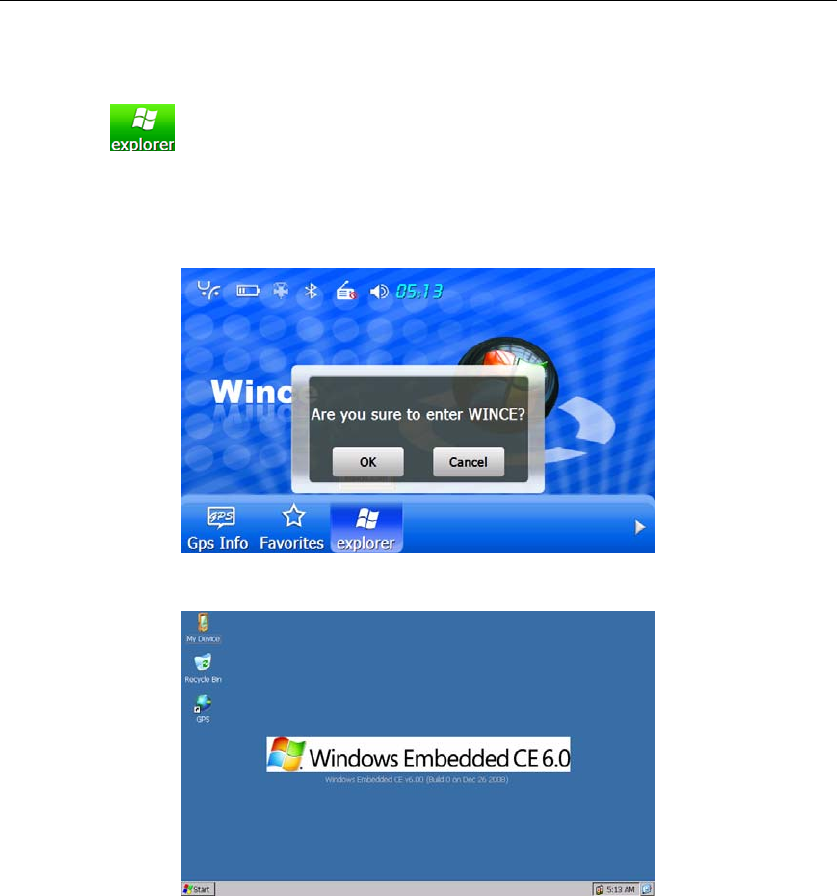
44
Chapter XI Explorer
Tap the icon in the system main interface to popup a dialog box indicating whether to enter the
WINCE system, tap「OK」to enter the WINCE system as shown below while tap「Cancel」to return to the
system main interface.
In the above interface, double tap the icon “GPS” to return to the GPS main interface or push the
Reset button backside the navigator to restart up the system.

45
Chapter XII Troubleshooting
Please carry out the following operations in case of abnormal operation of the GPS
navigator. For further problems, please contact our customer service center.
Fault Reason Solution
Low battery Supply external power and charge
the battery.
Startup failure
System down Reset the GPS navigator.
Sudden power cut Low battery Supply external power and charge
the battery.
Low backlight Turn up the backlight. No/ vague display
Backlight off Tap the screen with the touch pen.
Incorrect tapping response Touch screen not
calibrated Recalibrate the screen.
Low volume Turn up the volume. No sounds
Poor contact of
earphone
Check the earphone connection.
Communication with PC Poor USB
connection Check the USB cable connection.
GPS signals reception
failure Poor GPS signal About 3 minutes are needed for low
intensity of local GPS satellite
signal.
Loss of map data Accidental deletion Contact your agent or distributor.
Input a new password after
recovering the GPS data.
Note: This document is for guidance only and the content is subject to change without notice.
This device complies with part 15 of the FCC rules. Operation is subject to the
following two conditions: (1) this device may not cause harmful interference,
and (2) this device must accept any interference received, including
interference that may cause undesired operation.
NOTE: The manufacturer is not responsible for any radio or TV interference
caused by unauthorized modifications to this equipment. Such modifications
could void the user’s authority to operate the equipment.
NOTE: This equipment has been tested and found to comply with the limits for
a Class B digital device, pursuant to part 15 of the FCC Rules. These limits
are designed to provide reasonable protection against harmful interference in
a residential installation. This equipment generates uses and can radiate
radio frequency energy and, if not installed and used in accordance with the
instructions, may cause harmful interference to radio communications.
However, there is no guarantee that interference will not occur in a particular
installation.
If this equipment does cause harmful interference to radio or television
reception, which can be determined by turning the equipment off and on, the
user is encouraged to try to correct the interference by one or more of the
following measures:
- Reorient or relocate the receiving antenna.
- Increase the separation between the equipment and receiver.
-Connect the equipment into an outlet on a circuit different from that to which
the receiver is connected.
-Consult the dealer or an experienced radio/TV technician for help.